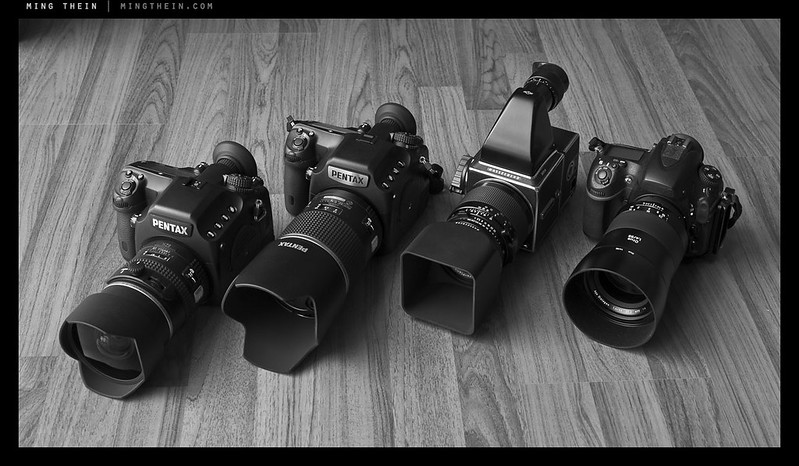
The contenders. From L-R: Pentax 645D, Pentax 645Z, Hasselblad 501CM with CFV-39 digital back, Nikon D800E.
Four cameras, 166 megapixels, no sensor smaller than 36MP and 36x24mm. It’d have been nice to get the Phase One IQ250 and Leica S along for the ride too – sadly there’s no Phase distributor in Malaysia and nobody from P1 has ever replied any email I’ve sent though. So we’ll make do with four: two from the old CCD guard and two from the new CMOS challengers. Lining up on the right are the Pentax 645D (33x44mm, 40MP) and Hasselblad CFV-39 on a 501CM body (49x37mm, 39MP) against the Pentax 645Z (33x44mm, 51MP) and Nikon D800E (24x36mm, 36MP). Perhaps we should have gotten one of the 41MP Nokia PureView phones along for kicks, too. That said, the rationale behind these choices is as follows a) I had access to them; b) to build a more or less complete system would be roughly the same price; Nikon and Pentax new lenses are more expensive than the used screwdriver Pentax FA or Hasselblad V glass; by the time you add everything in, the 645Z is obviously the most expensive option – but also arguably has the highest IQ potential. Welcome to part two of the Pentax 645Z review – the first part can be found here.
A note on testing methodology and lens choices:
- All cameras were shot raw and processed through ACR CS5.5, because this is what I normally use in my workflow.
- Color profiling has been left to Adobe’s defaults. I wouldn’t do this in the real world, of course – I apply custom profiles to all of my cameras to make results visually consistent.
- No noise reduction was applied – switched off in camera and zeroed out in ACR except for the identical default 25% chroma NR applied to all cameras.
- No sharpening was applied to any of the comparison images
- Adobe’s own lens profile corrections were used for all cameras to take the glass out of the equation as much as possible.
- White balance was achieved by using the eye dropper tool on the same location for all cameras, but the 645Z came the closest to getting it right.
- Ideally, I’d have liked to have picked the best lens for each system – the 55 or 90mms for Pentax; 45 or 85mm PCEs or the Zeiss Otus or 135mm APO for the Nikon, and the 50 Distagon or 120 Macro for the Hasselblad. Unfortuantely, this would have made any comparisons meaningless because of magnification differences; I therefore went with the only lens combination that would match fields of view on all three sensor sizes: 60mm, in 35mm EFOV terms. That’s the AFS 60/2.8 Micro-Nikkor on the D800E, the FA 75/2.8 for the Pentaxes and the Zeiss CF 2.8/80 Planar for the Hasselblad.
- A best attempt at matching DOF was made – f5.6 for the Nikon, f8 for the Pentaxes, and f11 for the Hasselblad; sufficient for the lenses to be in their optimum zones, but not so much as to make diffraction come into play.
- By extension, everything said about the D800E applies to the recently announced D810, too.
- Everything other than the ISO test series was shot at base ISO (100 for all cameras) on a heavy Gitzo 5-series tripod and Arca-Swiss Cube head.
- Focusing was accomplished through live view (where possible) or picking the best of repeated iterations (CFV). My D800E and 501CM/CFV viewfinders and focusing screens have been adjusted for perfect manual focus planarity; the Pentax 645s have not – the loaner 645D is noticeably off, and my own 645Z is almost perfect (but out by a hair, I think).
- I won’t be uploading any full size files – there’s no point. Firstly, I don’t have the bandwidth; secondly, a jpeg on flickr isn’t going to tell you much about colour, and lastly, unless you’ve got a very accurately calibrated wide gamut display AND the uncompressed 16bit TIFFs, we’ll be splitting hairs without a scalpel. I recommend going by what I say, not so much what you see in the web jpegs.
- Skin tone reproduction is something I have not explored yet. Partially because portraiture and fashion aren’t my speciality, and partially because my model/muse/wife is in hospital with dengue fever at the moment.
- A note on objectivity: I own three of these cameras (and two D800Es) and my aim is always to use the best tool to get the best result; I like to believe that I’m about as close to unbiased with the relative comparisons as you’re likely to find…
- Lastly, but importantly – a huge thank you to my buddy Darren at Autodetailer for the test location and subject material 🙂 You will notice some strange EXIF data on the 645Z images of the Ferrari 599; firstly, it is a metallic burgundy NOT rosso corsa, and secondly, it’s an available light studio with fixed fluro light banks, which means either tripod or high ISO. We were both short on time, so I opted for the latter – there are a number of images here shot at ISO 3200 or even 6400 – which is pretty darn amazing, considering just how well the camera has held the car’s color and handled the dynamic range across the scene. Think of it as a worst-case torture test of sorts.
What’s not obvious in this table is the difference between the 645Z and 645D is significantly larger in practice than the numbers would suggest. Firstly, the new camera is just so much faster in operation; it’s the difference between slightly frustrating and fluid. You needed to wait at least 3 seconds per shot for the buffer to clear on the 645D before being able to view an image; even menus were a bit laggy. Review is under a second on the 645Z, and reviewing/ zooming/ menus etc. feel much the same as the D800E: effectively instant. On top of that, autofocus is much faster and more precise; it locks on with more confidence and doesn’t seem to shift around as much during repeated refocusing. Again, speed- and accuracy-wise, it doesn’t feel much different to the D800E. Battery life is also noticeably better, and despite the increase in pixel count, the camera seems to be no more susceptible to shutter vibration than the old one; I presume we have a new mirror and shutter mechanism to thank for this. There are other operational improvements too, including addition of video recording, nearly 3x the continuous frame rate, and of course a vastly larger shooting envelop thanks to sensitivities that top out a whopping seven stops higher. And that’s before we even begin to talk about image quality.
Unsurprisingly, the newer generation of cameras handily trumps the old one – on the price/ performance ratio, at least. But this has been the way for as long as I can remember in this industry, and more so when we’re dealing with very niche products. I don’t know how many CFV backs Hasselblad sold in the three or so years before discontinuing them, but you can be sure it’s probably fewer than Nikon makes D800Es in a week. There are plusses and minuses of course to going with newer options. Firstly, there’s the whole debate over colour, bit depth and tonal response; I think at least part of that is justified. And the operational experience is very, very different. For the most part, conventional DSLR and DSLR-like mirrorless designs are very well integrated; there are still some UI aspects that could be improved – there always are. Medium format digital has mostly felt clunky to me: the camera part operates separately from the digital back part, and until fairly recently, they didn’t even talk to each other. There was a point when the camera and back powering on simultaneously from the same button was listed as a feature! Finally, we have the Pentax 645 twins: their operation is more seamless than any other medium format camera I’ve used so far (though granted I have not had a chance to try the new Phase One cameras) and its handling doesn’t need much introduction because it’s much like an overgrown DSLR. That can be a good and a bad thing – good because you’ve got a lot more room for external controls, bad because it means even more weight.
Even with this in mind, using the CFV is a unique experience. You have a 100% mechanical camera – any V series body – and lens on the front that’s of course capable of operating without batteries and independently of the back; you could even (gasp) load film into another back and swap it out if you wish. The back operates independently from the rest of the camera. The only way they communicate is via the little pin that protrudes from the camera body and used to advance the film counter; before the exposure, when the auxiliary shutter curtain rises, the pin extends into the back which wakes it up and primes the sensor; the leaf shutter is closed at this point so the whole camera is light-tight. Then the shutter in the lens fires, determining the exposure, and the pin moves back into the body, ending the exposure. So in effect, the exposure time of the digital back is always much greater than the actual exposure time determined by the lens. Presumably, there’s some clever software or noise reduction circuitry in there to prevent long exposure shadow noise – though this is already slightly higher than for most cameras, it’s not easy to determine if it’s the result of each actual sensor-on time being at least 0.5-1s or something else.
Regardless of all of this, if you enjoy the experience of shooting with an older, fully mechanical/ manual camera like a film V-series, this is as close as you’re going to get in the digital world. Remarkably close, in fact, other than the crop factor (1.1x, 645 – not square, sadly, unless you don’t mind a 37x37mm sensor area). I still think the V series design is one of the most fluid in use – all of the critical controls (focus, aperture, shutter) are all on the lens itself, easily preset, and viewable at a glance. And you even have program mode because the aperture and shutter rings are coupled on most of the lenses. However, this system as a digital option has one enormous catch: because the film capture area was meant to be square, the viewfinder and controls were laid out in such a way as to only work in one orientation. However, the digital sensor is a 645 aspect ratio: in order to shoot verticals, you need one of the 90 degree prisms and a grip, or a tripod. Leaf made a series of backs with an internally rotating sensor, which was a clever solution; Phase One P backs could mount in either direction (but run the risk of dust and moisture ingress) – either way, you’d still need a special viewfinder mask or focusing screen to show both vertical and horizontal orientations. Personally, I found the prism + grip solution much better for stability and general usability.
When seriously considering one of these imaging monsters, it’s also important to look at the types of subjects you shoot, and the lens choices and general system accessories available. Whilst the V series is perfect for studio work because the leaf shutter will give you flash sync all the way to their 1/500s maximum speed, and relatively small maximum apertures (f4 for all of the leaf lenses except the 80mm, which is f2.8) and manual focus only aren’t very important, they’re not so good for outdoor reportage and available light work – precisely because you’re restricted to f4 and 1/500s. In the tropics, or in any kind of bright sunshine, that means using ND filters (focusing becomes tricky), having almost no depth of field control and running into diffraction issues, or overexposure. By the same token, the Pentax 645 system is not the best choice for studio shooters: flash sync is just 1/125s because of the focal plane shutter and a lack of leaf shutter lenses; however, you do get a 1/4000s maximum overall speed, and most of the lenses are f2.8. The Nikon D800E splits the difference – 1/8000s maximum shutter, 1/250s sync speed, and lenses down to f1.2 (mostly f1.4). It’s easy to see why the D800E has been making serious conquests over both documentary and studio professionals – I deploy mine under both situations to equal effect. However, it still renders like 35mm. The difference is seen mostly at normal angles of view and below: it’s difficult to describe exactly, but wides look wide. There’s a definite difference in the way the Zeiss 2.8/21 renders on the D800E as opposed to the Pentax 25/4 on the 645Z – even though the Pentax is actually wider at an equivalent 19mm horizontal field of view, it doesn’t feel as wide as the Zeiss. Something to do with geometric projection, perhaps.
But I digress: all of these three options are mature systems. So mature, in fact, that legacy lenses for the Hasselblad V – proper made in Germany Zeiss glass, no less – go for an average of US$500-1000 a piece; non-SDM FA autofocus lenses for the Pentax are even cheaper, at somewhere between US$300-500. And there’s absolutely no shortage of Nikon glass whatsoever, though not all of it will be able to perform to the expected level on the D800E’s sensor. This is an important point to note: all of these sensors are relatively high density and will test lenses to their limits, especially the D800E; a lack of good lenses is its achilles’ heel. The others suffer to the same thing to more or less the same degree, so it’s very important to know that the focal lengths you need are adequately served. I would say that there are actually very few lenses indeed that can be used on digital without reservations to distance or aperture on all three of the systems (there may be others which I haven’t tried):
- Hasselblad V: 4/40 IF, 4/50 FLE, 4/120 Makro-Planar, 4/150, 4/180, and the Superapochromats
- Pentax 645: D-FA 25/4 SDM, D-FA 55/2.8 SDM, D-FA 90/2.8 SR SDM Macro – and perhaps the FA 200/4 if focused manually with live view.
- Nikon D800E: Nikon 24 PCE (beware sample variation), 45 PCE, 85 PCE, 85/1.8 G, 70-200/4 VR and the superteles; Zeiss 2.8/21, 2/50 Makro-Planar, 1.4/55 Otus, 2/135 APO
You’ll notice this is not a very long list at all, and only Nikon has anything tilt shifts. Hasselblad has the clunky Flexbody and somewhat less clunky Arcbody, but operation of both with digital backs is fraught with risk as you must remove the digital back to focus and frame between every exposure. On top of that, most of the lenses will have edge CA and purple fringing issues when tilted or shifted. Realistically, this means that architecture still remains the preserve of the Nikon system for me. Product photography too either requires stitching or tilt shifts; it’s easier to get it right in camera, so again – we’re back to Nikon for most things. For portraiture, fashion, reportage/ documentary, travel, landscape etc – pick your poison. That actually means for these things most people use their cameras for, you’ve got a lot of options; this is not surprising since all of these are mature systems which have had the benefit of many decades of professional photographers to refine.
A note on Hasselblad-Zeiss V glass on the Pentax 645: it can be done, because the V has a longer flange distance than the P645. I conducted some informal tests but didn’t have a chance to present them properly. In short, the Zeiss V glass outperforms the legacy FA Pentax lenses (75/2.8 vs 2.8/80; 200/4 vs 4/150) by a noticeable margin, wide open or stopped down. The Zeisses tend to start off a bit softer but improve more through f8-11; the Pentaxes start off a bit better and have better near performance, but don’t improve as much when stopped down. The difference between the 200/4 and 4/150 was so great that I’d probably pick the 4/150 over the 200/4; despite 33% more focal length, extra resolved detail is negligible. You’re going to be using both of these on a tripod anyway, so stability is a non-issue for the most part. Microcontrast and color rendition are better, and the output simply appears to have more ‘punch’ without being harsh. However, the new Pentax SDM lenses are all on par or better – the 55/2.8 is slightly sharper than the 4/50 FLE, which suffers from some focus shift as a consequence of the FLE group; the 90/2.8 SR blows the 2.8/80 out of the water, and is slightly better than the 4/120 Makro-Planar all over. There is no Zeiss equivalent to the 25/4. Food for thought. Note also that because of the much longer flange back distance compared to say 35mm and mirrorless, production tolerance issues are much less noticeable.
At this point it’s probably worth mentioning the competition – Hasselblad’s own H5D-50C, and the Phase One IQ250. Both of these have more extensive lens systems with some tilt shift options (or the 1.5x HTS tilt-shift converter for the Hasselblad) and autofocus, but a significantly increased price – north of US$27,000 for the H5D-50C, and $32,000 for the IQ250. In today’s strained commercial environment, such expenditure is extremely difficult to justify by most pros – including myself. In comparison, if you need another Hasselblad V body, you can probably find a nice one for about $800 – including a film back, waist level finder, and possibly an 80mm lens, too – they tend to go as kits. The body only might be $400-500. I can make medium format digital pay off for me, at that level the ROI is much lower than I’d like – and that’s before we even count the cost of adding lenses. There are two enormous reasons why they can ask for that much money and still find buyers, though: autofocus + leaf shutter/ high speed flash sync, and professional support – at least in the rest of the world. Phase One is pretty much nonexistent in Malaysia, which makes it a non-starter for me; I don’t need high speed flash, and even if I did, I prefer to use speedlights, so running a separate NIkon system is both cheaper and more flexible. However: your requirements and local options will almost certainly differ, and this should be taken into consideration, too.
Let’s move on to the more quantitative part of this comparison. Again, I emphasize that you should go by what I say, not the small web jpegs. Since the whole point of the exercise is to chase the last fraction of a percent of image quality, viewing these images at anything but maximum quality – uncompressed full-fat TIFFs on a calibrated monitor – is rather meaningless, and I simply don’t have the bandwidth to serve them. I’ll break down the assessment into a few categories. Even so, at base ISO, the results are much closer than you might think. Click through to the images on flickr for larger versions.

For reference – applies to all of the images which are divided into four panes.

First test scene, processed to final.
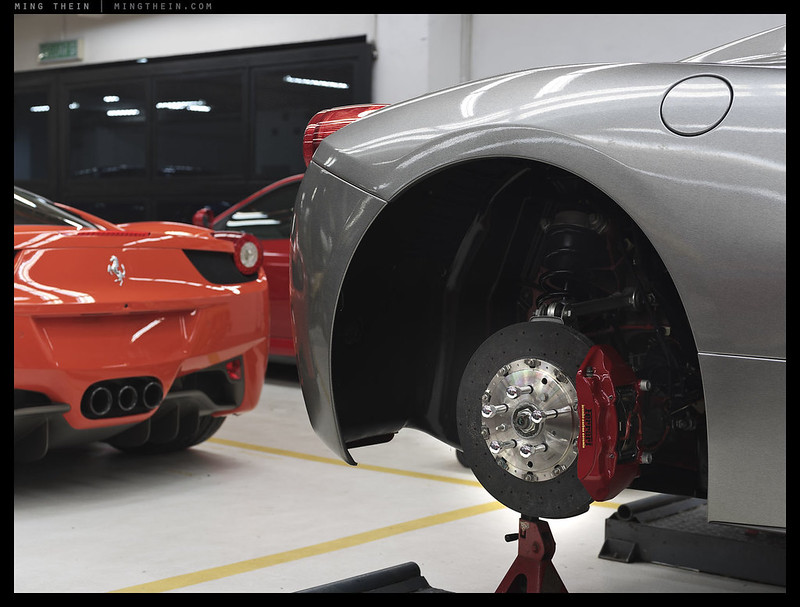
Second test scene, processed to final.
Resolving power
Our ‘lowest’ resolution camera here weighs in at 36MP; the highest, 51. Though this is an area difference of some 40%, the linear difference is much less – more like 20%. It’s basically going from a 10×15″ to a 12″x18″, or more like 12×16″ due to the difference in aspect ratios. Pixel pitch also plays a secondary role here: the smaller the pixels, the less acuity there is because all other things being equal, the signal to noise ratio is lower and this affects acuity. (Of course, there is some oversimplification here as lenses also play an important part in the equation.) What’s telling though is that only the D800E and 645Z don’t appear to have any significant resolution compromises with increasing ISOs; edges don’t start degrading until very late in the day. Bottom line though: to see a consistent difference, you’re really going to have to be employing optimum shot discipline all of the time; otherwise that 20% is going to disappear very fast indeed.
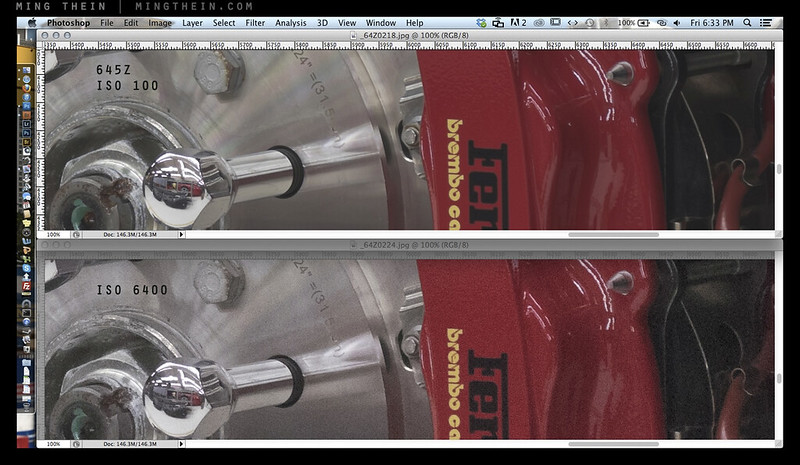
From the 645Z. I think there’s no question that there’s a frightening amount of resolution here – note the reflections in the bolts, and the textural differentiation in the brake calliper. Remember, this image has not been sharpened. More impressively, most of this detail holds through even ISO 6400.
Dynamic range
The first time I used the D800/E, I was surprised by firstly how flat the raw files looked, then by just how much latitude they held – in both shadows and highlights. There’s probably an easy 1.5-2 stops at both ends; practically, the D800E seems to have around 13.5 usable* stops at base ISO. Put it this way: if exposed properly, it rarely clips. Being used to the D800E, I found the 645Z even more impressive: it almost didn’t clip at all, despite being shot under extremely high contrast situations during the test period. I’d say there’s at least a stop more dynamic range in there, perhaps slightly more than that. However, it’s worth noting that at least some of this (for all cameras) is attributable to the raw conversion since we only have 14 bit files to begin with. This is not to say that the 645D and CFV-39 are slouches in this department: far from it. I think both top out at around 12-12.5 stops; they certainly clip with more regularity than the D800E, let alone the 645Z. This is more of an issue for the 645D, because it doesn’t appear to handle overexposure with as much grace and smoothness as the CFV; pixel pitch probably has something to do with it. The CCD cameras lose dynamic range very quickly as sensitivity rises; basically, one stop for every one stop gain in ISO. This isn’t quite the case with the CMOS cameras, which only start to visibly lose dynamic range over about ISO 800 (D800E) or 1600 (645Z). The difference is further compounded by the fact that the two CMOS cameras had more dynamic range to begin with.
*The definition of ‘usable’ is also highly dependent on how tolerant you are of shadow noise.
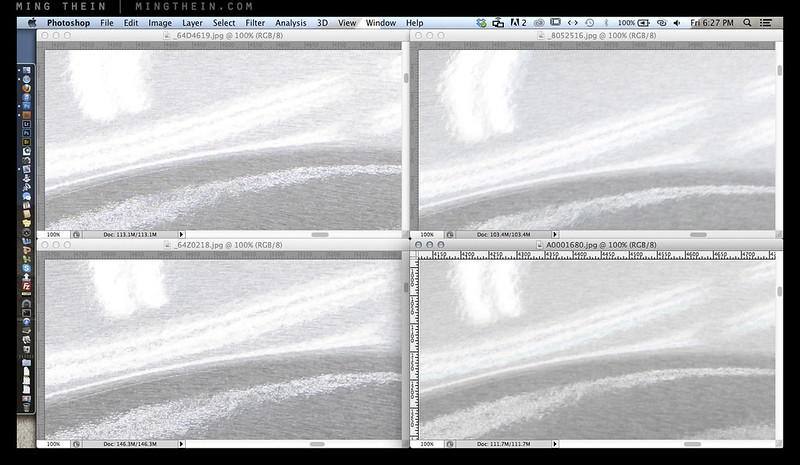
Highlight dynamic range, ISO 100. Ignore the slightly different focal planes/ depths of field.
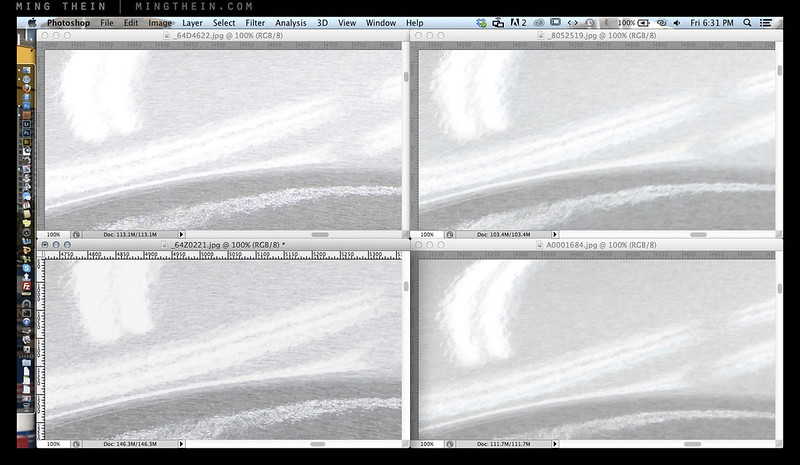
Highlight dynamic range, ISO 800. You can see all of the cameras starting to block up slightly, the D800E appears to be handling this slightly better than the other cameras. Still impressive just how much of the highlights they’re holding, and how smooth the rolloff is – despite being a very hard reflection.
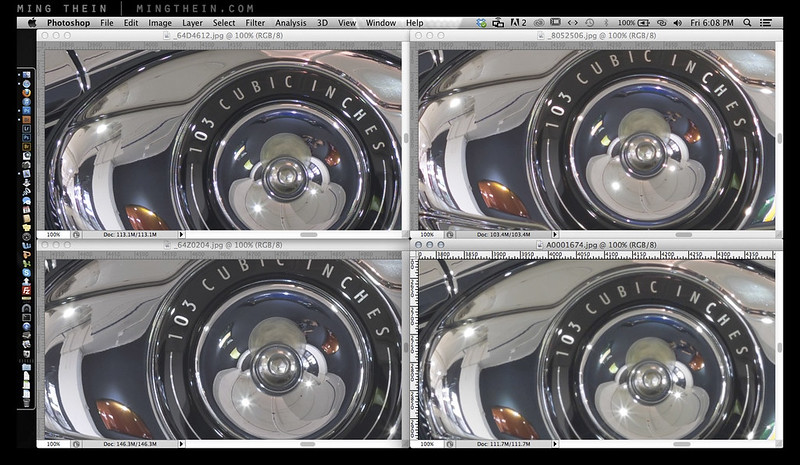
Midtone dynamic range, ISO 100 – none of the cameras is having any issues here.
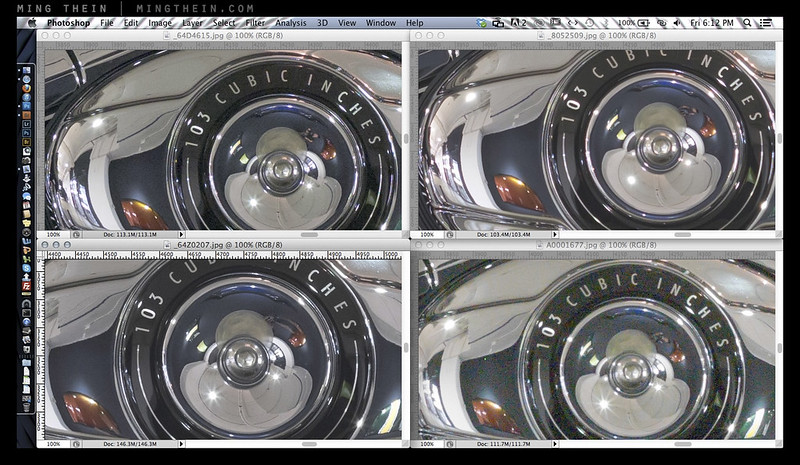
Midtone dynamic range, ISO 800 – you can see the two CCD cameras starting to struggle with both noise and shadows crushing; the tonal response is starting to become a bit weaker, too.
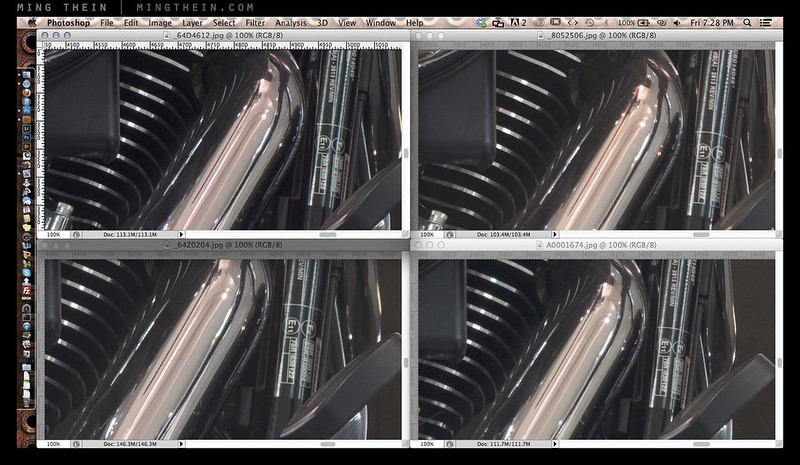
Shadow dynamic range, ISO 100 – all of the cameras have no problems holding the entire dynamic range of the scene without clipping; however from the density of blacks it’s clear that the 645D is the weakest of the four, followed by the CFV (though it has quite a high noise floor compared to the other cameras); the 645Z leads the D800E by about a stop.

Shadow dynamic range, ISO 800 – If we take a look into the shadows, you can see the CMOS cameras pull far ahead – the 645Z looks to be a bit lighter than the D800E, despite an identical highlight exposure, which suggests that most of its extra dynamic range lies in the deep shadows. The CCD cameras, on the other hand, are starting to lose detail and dynamic range; in the case of the CFV, we’re losing pretty much everything below Zone IV.
Noise
The 645Z and D800e walk away with this one; whilst all of the cameras look pretty much the same at ISO 100, you’ll find that the noise floor is much lower on those with CMOS sensors. Beyond that, the CFV starts to fall apart at IS0 400, and earlier in the deep shadows – notice how quickly luminance noise starts to set in. We get another stop out of the 645D to about ISO 800; even 1600 is actually usable at a pinch, though expect to have lost many stops of dynamic range in the shadows. The D800E still looks much the same as the 645Z, and both don’t appear much different from base ISO. That said, though the highlights and overall histogram appear the same, the 645Z’s lowest zone is a bit lighter, which suggests that there’s more dynamic range than the D800E in here. In fact, the D800E remains relatively clean at ISO 3200, and ISO 6400/12800 can be used in a pinch with some postproduction NR work. Under this kind of (fluro) lighting, the 645Z appears to perform much the same.
Subjectively, this is somewhat different to my observations under more neutral white balance; the 645Z has a bit of an edge over the D800E in those situations – by as much as a stop. I’d say the 645Z’s higher 25k and 51k sensitivities can be used if you don’t mind downsizing. In fact, a 645Z file downsized to match my D4 blows it out of the water in noise, acuity and dynamic range – by more than two stops. Remember, for a given output size, the increased amount of information to begin with in the 645Z’s files are going to mean that even if noise at the pixel level is the same as say the D800E, you’ll still get a noticeably cleaner result. And that’s not quite the case, because this camera is about a stop or so cleaner at the pixel level, too. It’s also worth noting that the CFV-39 has no microlens array over its sensor; this means that its light gathering ability isn’t quite as good as the other cameras. Its actual ISO seems to be about 2/3 stop less sensitive than the others despite having the same numerical rating – important when taking into account flash and other exposure calculations. Also, the CCD cameras will punish underexposure and post-processing recovery quite badly with noise and colour shifts in the shadows; this penalty doesn’t seem to be anywhere near as harsh with the CMOS cameras.

ISO 100. What follows is a series of crops at every ISO; the CFV tops out at 800, which we’ve left in for the last full comparison at ISO 1600. Thereafter it’s down to the two CMOS cameras. I stopped at 3200 – this is probably about the limit for what I’d consider very good quality after some noise reduction/ cleanup; 25k was thrown in for kicks and entertainment.
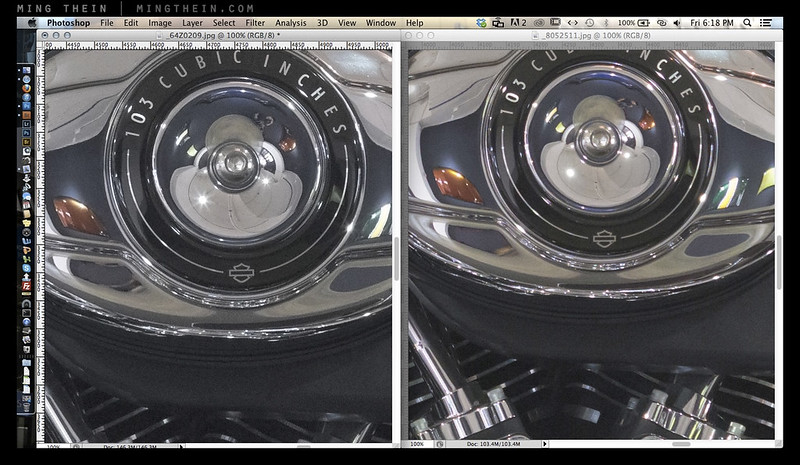
ISO 3200 – 645Z on the left, D800E on the right. Notice the 20% linear difference in image size isn’t quite as much as you’d expect.

ISO 25600. Apply PP NR, downsize and you’ll actually have a surprisingly usable file.
Color and tonal response
Firstly, it’s important to know that all of the images from each set had their white balance set on the same object in the scene, using a 5×5 pixel sample eyedropper; this should be about as close to consistent as possible. I used the default Adobe conversion without custom profiling. I’m sure somebody will say at this point that there is better software for each camera; I agree, but from a consistency, comparability and workflow point of view, ACR is still very much the way to go – especially if you happen to be mixing multiple cameras on a job, which I will probably land up doing. There is only one 16-bit camera here; does it produce more accurate colour than the rest? No. More pleasing? Perhaps, but that’s subjective. The only place where the CFV is demonstrably better is in reproduction of the reds in the tail light; it’s much closer to accurate than the 645D or D800E, which are far off; interestingly, the 645Z is closer to the CFV despite having architecture and processing that’s much closer to the other two. Skin tones, blues, greens etc – yes, they’re missing from this comparison, but there’s only so much I can physically do in two days. In any case, it’s not a big deal to profile the colour of any one of these cameras (or all) to be the same as the CFV, or consistent with a fifth reference. I know for a fact that my custom profile for all of these cameras will be more like the latter. I just want to make one comment about all of the cameras: there’s remarkably little hue shift as the sensitivity increases even to 6400 or thereabouts (with the exception of the deep shadows of the CFV, which have been polluted with chroma noise); we see some desaturation but this is to be expected.

ISO 100. Strong tonal differentiation of fine gradations even into the shadows from all cameras, as expected. Color reproduction is actually remarkably similar here.
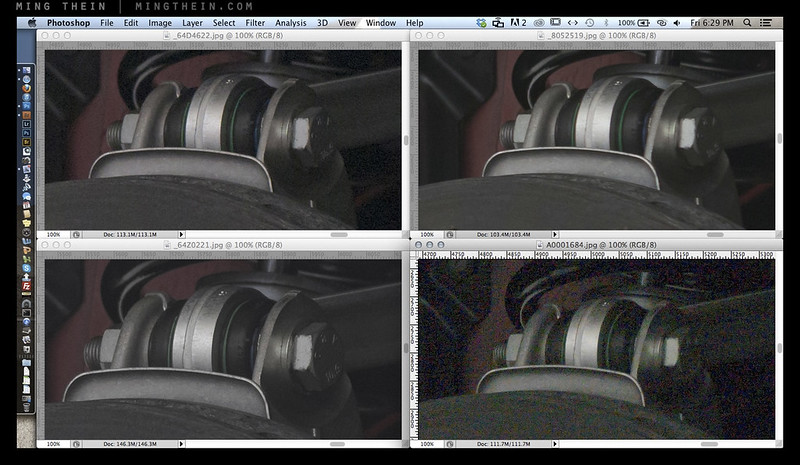
ISO 800. Not quite the same story; the CFV has acquired a green hue shift, the 645D has increased in contrast as its dynamic range contracts, and the two CMOS cameras look almost the same as at base ISO.

ISO 100. This is a bit more interesting: one of the trickiest hues to reproduce accurately are deeply saturated reds; Ferraris, transparent clear plastic tail lights, maple leaves and the scarf of my polar bear all fall into this category. Early digital cameras would blow the channels very quickly, to the point of being unusable unless you underexposed by 1-2 stops – at the expense of the rest of the image; we’ve come a long way since then. Here, the same point on the car’s bodywork was used as a white balance reference. The 645D and D800E are both too orange, with the 645D being the least accurate. The Hasselblad and 645Z are closer to the mark, but neither quite nails it – the Hasselblad is too pink, and the 645Z still a bit too orange. I think the truth lies somewhere between those two.
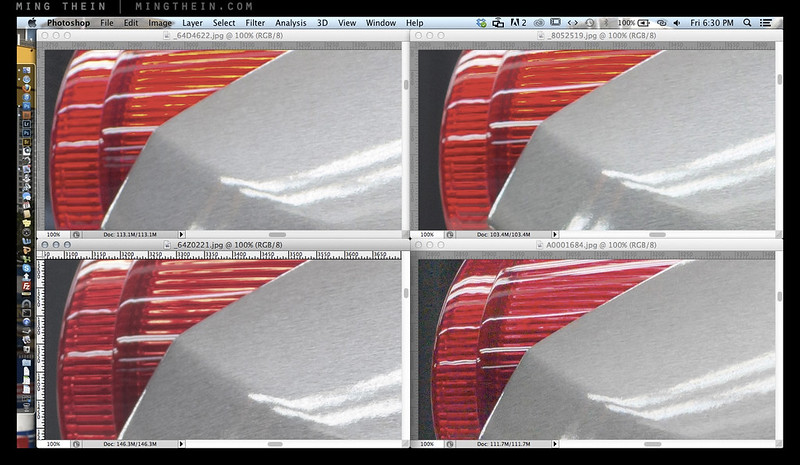
ISO 800 – and remarkably little hue shift or noise in this zone, even for the CFV.

The final image is to show a few things: at the same output size, how much depth of field separation you get from a given angle of view and real aperture – in this case, 60mm (35mm EFOV) and f2.8. The CFV’s format is double the size of the D800E, and as a consequence there’s a noticeable amount more defocus – as expected. There’s also slightly less depth of field (60mm plays 80mm). The second point I’d like to mention is colour again: the CFV has perfectly nailed the colour of the Ferrari, but the 645Z is a bit too dark and the D800E too orange. Still, the differences are relatively slight and easily correctable afterwards.
Shooting envelope
I think it’s no surprise here that the two newer cameras have the largest shooting envelope of all; I’d put the D800E and 645Z on par because what the latter gains in high ISO performance and resolution it gives up to faster lenses and a more flexible system to the former. It’s quite possible that the slight high ISO gain for the D810 may edge this somewhat in Nikon’s favour. None of these can exactly be considered light or compact, though the 645s with the diminutive 75mm aren’t too bad, and if you opt for the f1.8G primes for the Nikon (28, 35, 50, 85) you can pack a lot of image quality into not much space at all. I think the 645D lands up somewhere in no-man’s land; it’s really the low-cost starter option to see whether medium format is for you or not. And finally, the CFV combination is really a scalpel: it excels at some things, but definitely isn’t for every situation.
Of course, there has to be a huge amount of personal subjectivity to be taken into account. It may well be the operation of the CFV is so much more pleasurable to you than a digital-DSLR style interface, in which case the rest are non-starters; or price, which would favour the Nikon; or perhaps you’re allergic to manual focus or have vision issues, in which case the Hasselblad would be a non-starter – and you’d have to think very seriously about focusing the D800E, because it seems to be the most intolerant to focus errors of the lot – partially because of the pixel pitch, and partially because the focusing screen is nowhere near as differentiating as the others between in and out of focus areas. Haptically, none of these cameras are bad choices: they’re all mature, evolved designs. Even the blocky-looking Hasselblad V bodies are actually very comfortable to use; I actually find them very, very fluid in use and beautifully simple. I put my left hand on the lens controls, and my right hand cradles the bottom the camera body with my index finger on the shutter release; I had to be a bit careful when doing the comparison because the lens release is in the same place on the Pentax! On top of that, the camera itself (and the back, styled to match the chrome body) is a work of art – unfortunately, I can’t say the same about the 645Z or D800E; at best they are ‘functional’; quite frankly, the 645Z’s external design is something only its engineers could love. Still, it gets the job done. In any case, I highly encourage you to try them out in person before making a decision; ultimately, it will come down to personal preferences. Note: the film Hasselblad V bodies handle exactly the same as one with a digital back; the digital back is a little bit heavier and larger than a film magazine, but not by much.
It’s difficult to come to a clearly meaningful ‘which is better’ conclusion here, other than it’s clear that the 645Z succeeds and improves on the 645D by some margin, and unless you’re on an extremely tight budget (in which case you’re probably going to be better off with the D800E or D810 anyway) is really a non-starter option unless you must have that medium format look. If you only have the budget or weight/ space allocation for one system, I have to say go with Nikon – it’s the most flexible and will let you do probably 99% of what the others can. It’s also the only option if you have special purpose requirements such as tilt shifts or supertelephotos. Splitting the 645Z and the CFV is much harder; though there’s a definite resolution advantage to the 645Z over all of the cameras here – between 27% and 40% in area – I think the CFV trumps it very slightly in pixel acuity, though this may well be down to the lenses. I personally prefer the slightly biased warm colour native to the CFV, but this can be easily be adjusted for in post. I think there are two deciding factors here: firstly, whether you’re going to use it in studio or with available light, and secondly, the rendering. The former has to do with flash sync and high iso capabilities; effectively you’re trading off one for the other. The latter is something a bit more subtle: the larger the sensor, the more natural the rendering appears to be – at least to my eyes. I’m not talking about the super-shallow depth of field that’s a property of very large formats, but the way the focus transition rolls off, even at f8; it tends to be much smoother and more gradual than the abrupt ‘planes’ we’re accustomed to with fast lenses and 35mm DSLRs. I guess what I’m saying is that I can see a reason to keep both the CFV and 645Z around – unfortunately, my accountant is telling me otherwise…MT
The Nikon D800E is available here (B&H, Amazon). The D810 is available here (B&H, Amazon). The Pentax 645Z is available here (B&H). The Pentax 645D is available here (B&H, Amazon) – though I suggest hitting up Japan Camera Hunter to find you a nice used one from Tokyo instead at significantly less cost. The Hasselblad CFV-39 is sadly discontinued, but the CFV-50 (50MP) is still available here from B&H.
__________________
H2 2014 workshops now open for booking – Making Outstanding Images San Francisco, Chicago and Venice; Masterclass San Francisco and Venice – click here to book or for more info
____________
Visit the Teaching Store to up your photographic game – including workshop and Photoshop Workflow videos and the customized Email School of Photography; or go mobile with the Photography Compendium for iPad. You can also get your gear from B&H and Amazon. Prices are the same as normal, however a small portion of your purchase value is referred back to me. Thanks!
Don’t forget to like us on Facebook and join the reader Flickr group!
Images and content copyright Ming Thein | mingthein.com 2012 onwards. All rights reserved
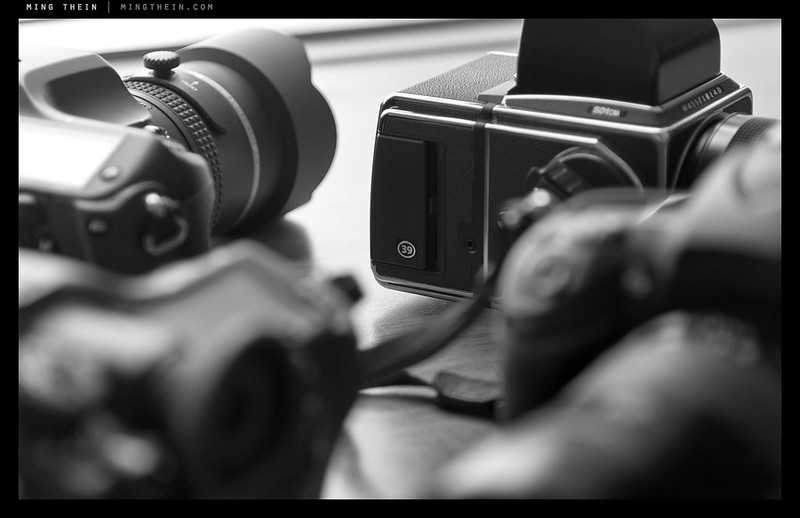
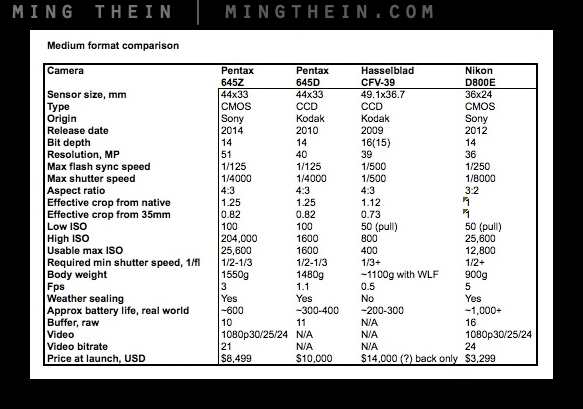
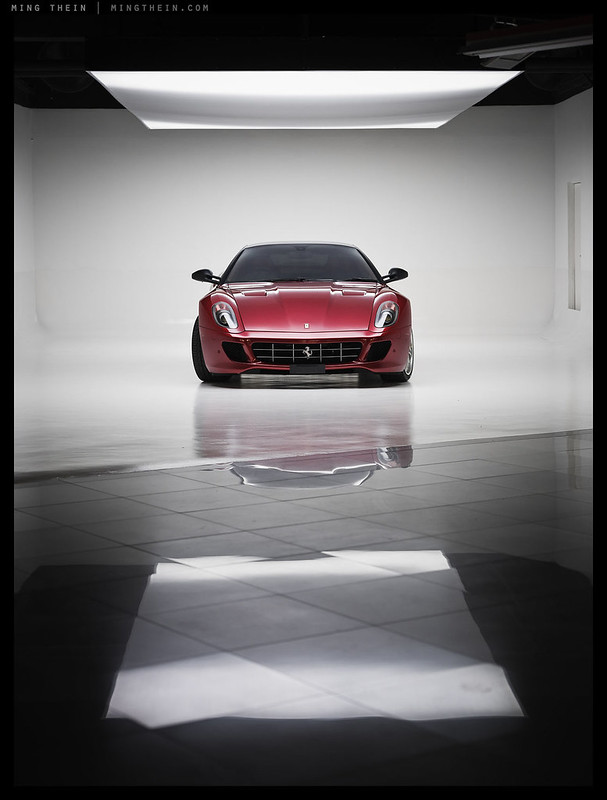
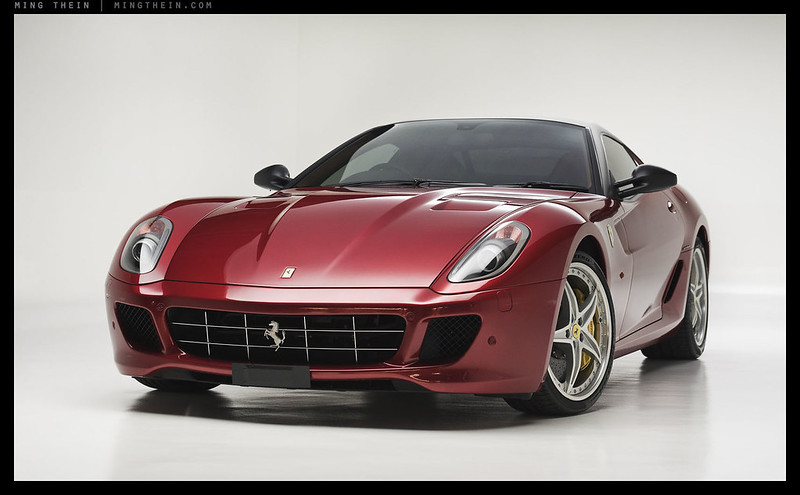
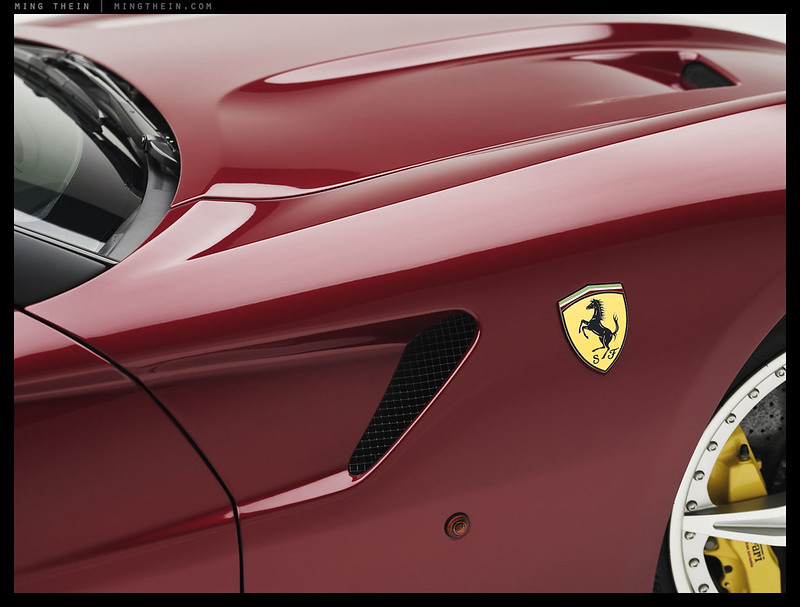
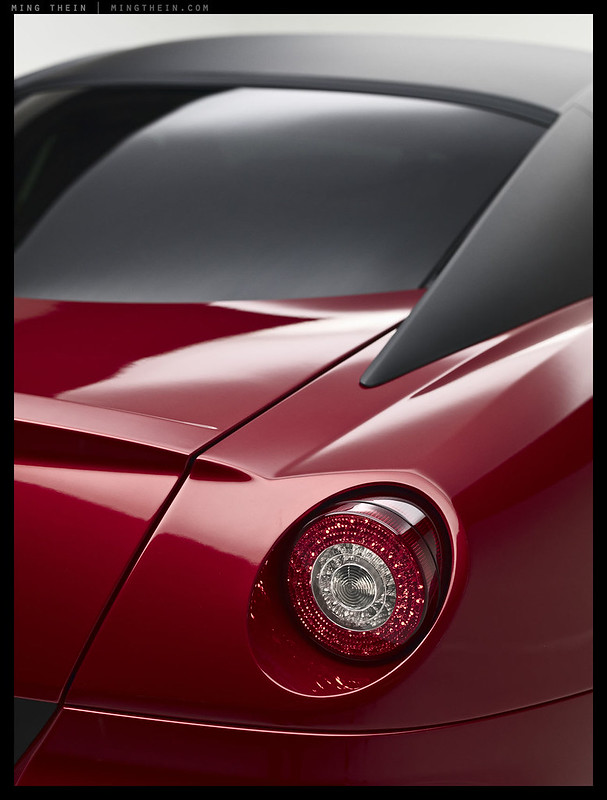
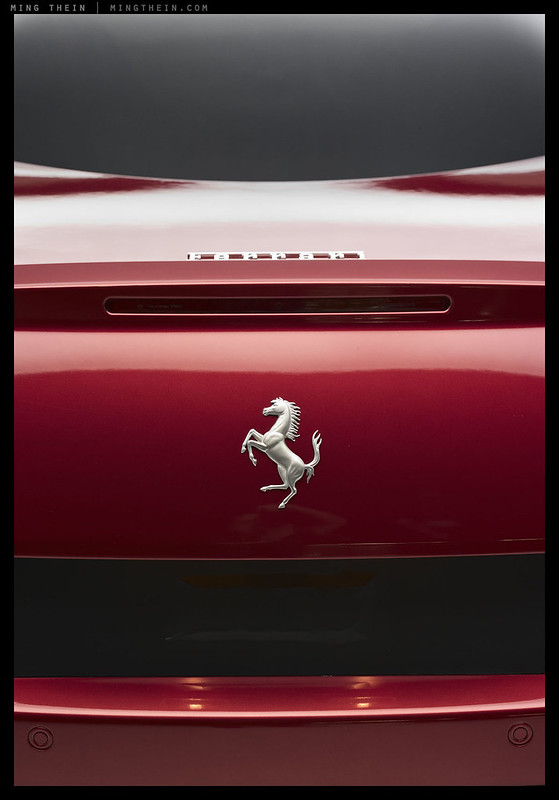
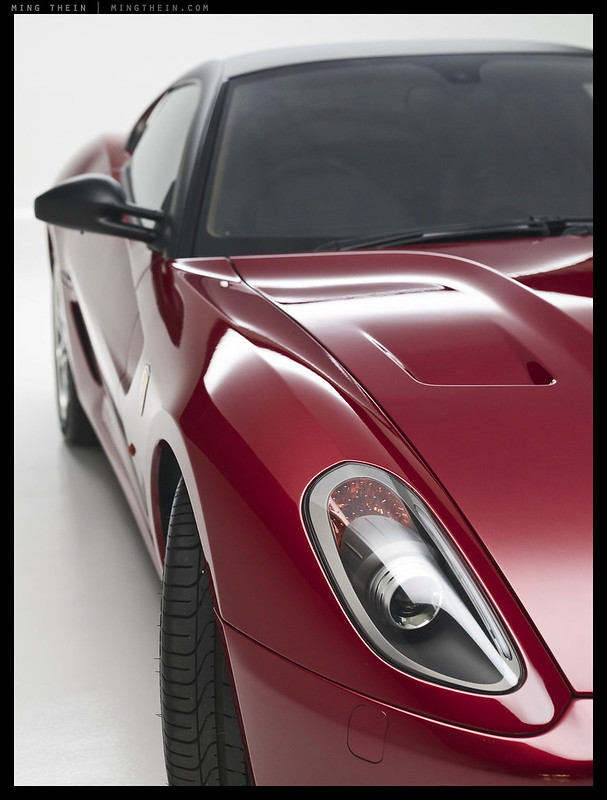
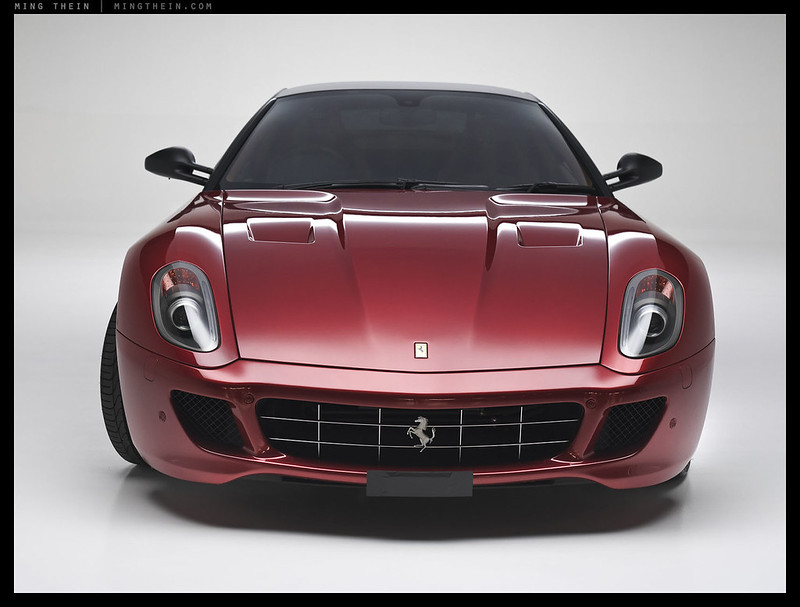
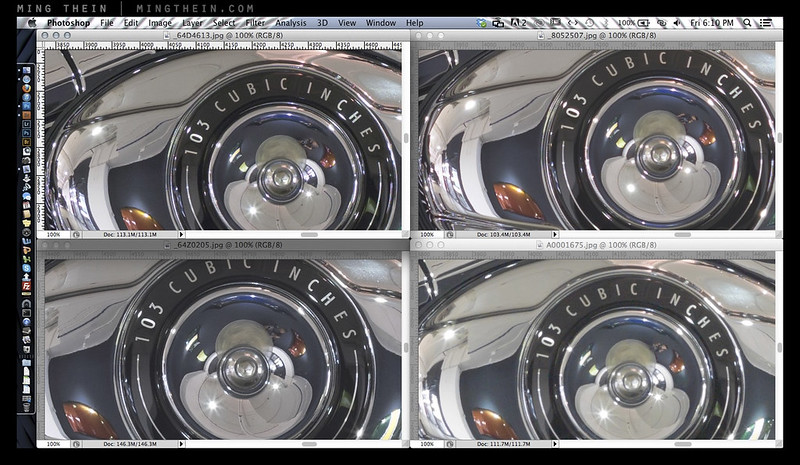
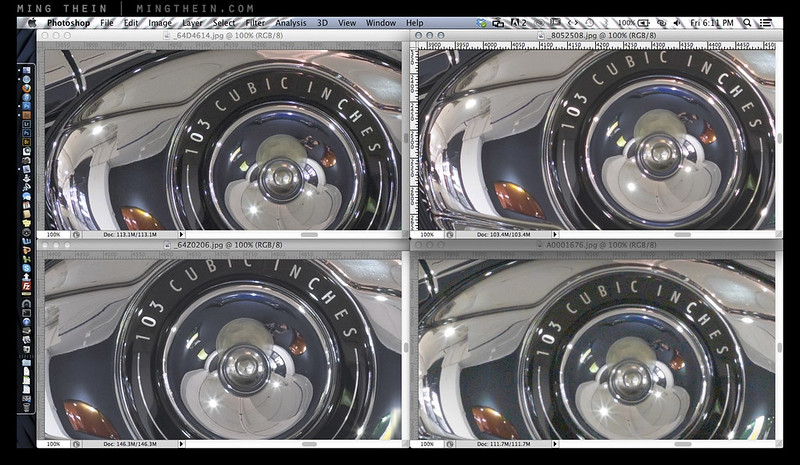

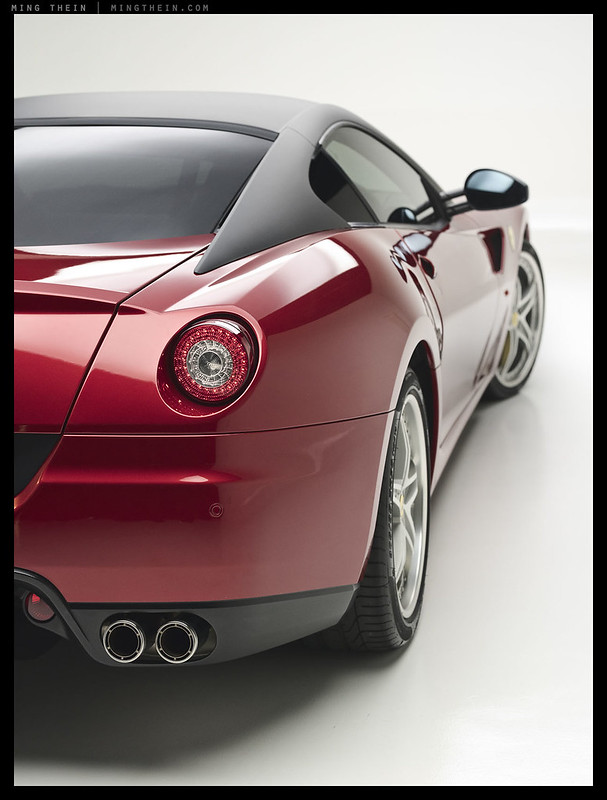
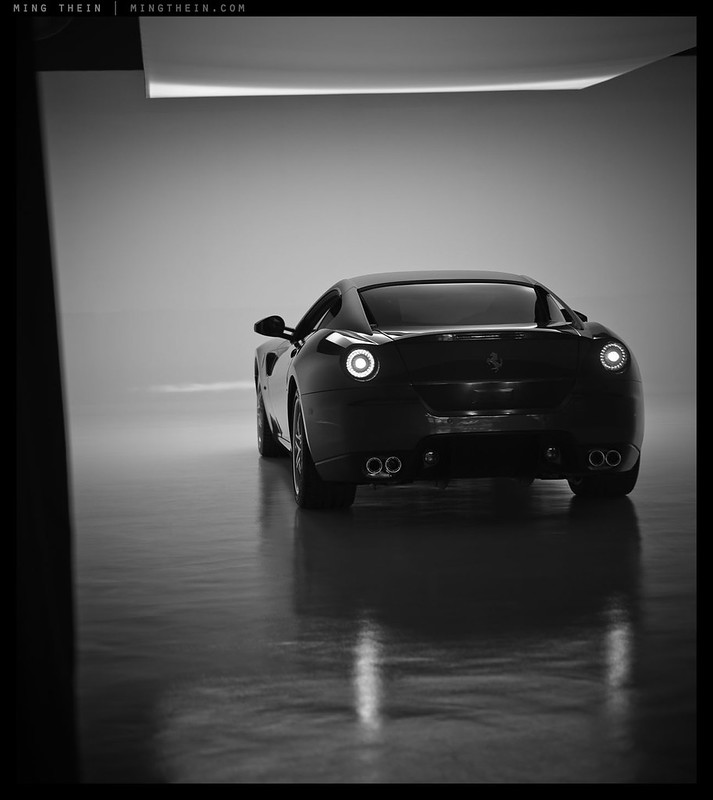






Hello Ming,
Thank you for putting together this through and insightful review. Kudos to you Sir!
Not sure if a similar question was already asked and/or addressed by others in this blog if so, I apologize in advance.
I am a fashion/live style photographer, a large number of my photo shoots are done in a studio. For the last year or so I am finding myself printing images (poster size or larger) with much more frequency for my clients.
I have an opportunity to purchase either a slightly used H4D-40 (may even be able to get 50 mp ccd) with a 80 mm lens or go with a 645z with a 80 – 160 mm. These 2 systems are in similar price range.
My question to you is this: Even after using color management tools like color checker etc… Would there will be a big difference in the way the ccd images will appear as opposed to the cmos? Will the ccd system have a more “medium format” look than the pentax cmos?”
I know that there are other variable like lens quality involved as well, but I wanted to get your opinion if possible.
Thanks in advance,
Ian
The bigger difference is going to be flash sync speed, especially if you’re working in a studio. Pentax: 1/125, Hasselblad, 1/800. As far as color differences go – you can make the Pentax look like the Hasselblad with some work; the Hasselblad has much better color/tone but less latitude for recovery or later work. Less dynamic range too.
Thanks for the reply Ming really appreciate!
As for the sync speed, yes 1/125th is a bummer but I may have found a possible solution:
One being http://www.priolite.com their strobes allow for sync speeds all the way to the max for the 645z.
Alternatively strobe heads like the speedotron 103 with their power packs – whose flash duration is quite long. As a consequence it will allow the 645z to be used at a higher sync speed (not sure of the limit yet) without banding. The same may also hold true for some of the Elinchrom RX Packs along with their slower (long duration) “S” strobes.
I wish I could get both of these systems, but that is in the realm of fantasy, at least for me. I am leaning more toward the 645z from an overall value perspective.
Cheers!
There’s a possibility you might lose some power if you use the high speed solution. The longer duration packs have the problem still of motion – it’s not the shutter speed that freezes motion but the flash duration (up to 1/20k with some packs, if I remember correctly).
You are right. I wonder if mixing fast strobes with slow or long duration heads will solve the problem for fast action or not. Makes one wonder if the pentax 645z can be used for fashion or is it simply to be billed as a landscape photographers gear only.
If you have continuous light, why not?
Great review, thanks for the effort.
I have finally found a blog/website (yours) that has real answers–and also quite enjoyable to read. You are photo/scientifically complicated, but also understandable to my sadly layman viewpoint. I am impressed by your lack of determined bias such as I have found with ALL of the other detailed websites of this caliber. BTW, my website search was for a simple Pentax 645D vs 645Z comparison–much more was gleaned and I appreciate that . . . .
Thanks Jay! Art isn’t necessarily independent of medium, but shouldn’t be subservient to it. It’s a tricky balance 🙂
Hi Ming…i want to ad a MF to my bag..i am used to canon..i own the 5ds…i would love the 645z but is too much money for me now..taking the 645d y could keep my canon equipment and leave 645d for portraits landscapes and personal work…is it a better iq compared to nikon d800? i want MF
thanks!
Ask yourself first *what* quality of MF you want: if it’s resolution, the D800/810 is about the same as the 645D. The 5DS exceeds it. If it’s tonal quality, then again the D800/810 exceeds the 645D because it’s a much older camera. If it’s the larger format look, remember that you can get much faster lenses for the 35FF systems than Pentax 645 (f2.8 max). I suggest renting one before making that big an investment.
Thanks for the comparisons, Ming! Always like seeing them (and like reading stuff on your blog).
One question. I’m a photographer and furniture maker and my company has allowed me to purchase a new camera, budget ~€7500 to document our custom work/portfolio shots. So far I’ve been using a Fuji X-Pro for most stuff (casual/workshop shots, in progress reports etc) and borrowing a friends Nikon D3 for finished jobs/more pro-looking shots. I’m considering a Canon 5D (MKIII or DS), Nikon D810 or one of the Pentax 645 lineup. I was thinking maybe the 645D so there’s some budget left for lenses, but it’s the same price as FF offerings from Canikon – and is the 645D good enough in comparison to choose it over a FF? I thought so initially, it being medium format and MF always giving the ‘feel’ of quality stuff, but your review made me doubt my options…
A D810 (or even D750) is more than enough. I’d spend more on lighting and tripod/support than the rest because it will make the biggest difference here…
Ming, in this day and age of advanced CMOS I’m still a bit of a sucker for the V. So, thank you for this comparison. Truthfully it has made it harder to justify the expense of a CFV but at the same time… I want one anyway.
Prices have come down a lot recently. The main challenge with the digital backs on V is none of them really do the square format well, and the ergonomics of that camera are best suited to square; shooting verticals requires a grip and 90deg finder or tripod. Too bad they never made use of the extra image circle over the crop factor to offer camera movements.
Your B&W work is exquisite. If you are ever in Oregon look me up. I would be your your location guide.
Thanks for the offer!
Hi Ming. Great review- thanks.
I know this review was posted quite a while ago so hoping you’re still viewing the comments.
I’m just about to get a 645z and I have a question that I can’t seem to find any answer to on the net.
With adapters such as the Hasselblad V to Pentax 645, I realise that everything is manual.
But will such an adapter actually work the leaf shutter in a V lens (I’m guessing not).
Is there a way to adapt other any brands old leaf shutter lenses to work on the 645Z? I’ve been looking at the old Pentax 67 LS lenses but they are supposedly pretty soft. And the old 75mm LS FA 645 Pentax lens is a pretty rare beast.
Can’t locate one at the moment but if all else fails I’ll just have to wait until one becomes available.
Thanks,
Gary
Nope, unfortunately it won’t. The adaptor is pretty thin, so I don’t see any easy way that it could trigger the leaf shutter. The only way I can see it working is a) have a recocking mechanism in the adaptor; b) cock shutter/close the lens; c) you put the camera in bulb/time, release first; d) set and trigger lens shutter; e) end bulb/time. Messy but possibly workable for studio strobes. I did think about doing it but gave up when I saw there was no way to shove a V-H or V-S adaptor’s guts (recocking etc.) inside the V-P645 adaptor’s volume. As far as I know only the P67 LS lenses work natively/easily. You could try a LF lens on a bellows (or Cambo thingy), which would be much easier to trigger/control since they’re designed to work independently of the camera backs anyway.
Dear Ming,
Thank you for your outstanding review!
I bought the 645Z some time ago.
One question: you write that “Adobe’s own lens profile corrections were used for all cameras to take the glass out of the equation as much as possible.”
However, it seems that Photoshop does not recognize the lens profile automatically. I am using Adobe PS CS6 from 2012
Any tips where to find the lens profiles?
Thanks, Arjan
Should be on the lens tab of ACR when you open the DNG files.
How much better is the D810 than the D800e? So, how much more can the D810 even close the gap to the Pentax 645Z in terms of overall performance/usability, flexibility (EFCS, Iso 64, AF accuracy /af group mode area, split screen live view, quiet silent shutter, better flash sync /higher shutter speed) ?
I covered that already in the D810 review here: https://blog.mingthein.com/2014/07/29/nikon-d810-vs-d800e-to-upgrade-or-not/
The improvements are mostly operational. Image quality is better in some areas, a little worse in others (noise). The 645Z still retains the image quality title by some margin.
But if you consider the different format ratios (645Z 4:3 vs. D810 3:2) and would compare both on 3:2 format (cropped 645Z file) the resolution advantage would decrease but i know the sharpness, DR and color accuracy will still be better on the Pentax!
But how much then…..personal preference if worth to pay 1 1/2 times more….overall i think the d810 is still the much better, mature system for the majortiy of enthusiast amateurs more flexibility, better faster/snappier af, broader & wider lens selection (ultra wide angle, tele, standard zooms and let alone t&s lens not any pentax one avaiable…., flashes, flash sync, shutter speed arguments for the d810 as well)!
Why bother asking if you’ve already made your mind up?
Moreover, it’s a false comparison because if you shoot the D810 at 4:3, the advantage is even more in favor of the 645Z.
Pentax 645D is better. Best
really good review! thank you very much Ming.
just a question. I’m a landscape photographer and I still use films (MF and GF) but now I’m thinking to buy a digital camera that lets me do also quite big prints. I have a Pentax 67 with all the lenses. I know they fit on the 645Z, but I wasn’t able to find someone who tested them. any experience about, especially with wide-angles? I guess old lenses are smoother than the newest ones…
thanks for your suggestions.
best, Andrea.
No, sorry. I don’t have any 67 lenses.
Great article, i’m planning on getting the 645z, to use with my older 67 lenses. Do you know where I can find these adapters? These seems to be no obvious place you can find them…thanks!
Ebay is a good place to start…
Ming, thank you again for the quality of your insights, reflections, and the production values you incorporate into your blog articles. While the latter is top notch, I, and no doubt many of your discerning regulars, am particularly drawn by the calibre of your insights (for as long as you care to share them & not go spare with the pressure).
Your training as a physicist, combined with your diverse career background, give your photographic commentary exceptional depth (and every thinking photographer appreciates that).
As for me, I find your non-consumerist passion & measured comments absolutely refreshing. Of course, you still enjoy the gear – even prize it when it’s good. But, even as we are goggling at the capacity of these high res beasts, you weave in matters of talent and intent and, reading other people’s considered comments, we all respect that.
A pleasure. Thanks!
Thank you for providing such an EXCELLENT review! Heads and shoulders over all others I’ve read!
Thanks!
How to make Tilt/Shift with Pentax 645? I found an adapter Zork, but I don’t know whether it will work properly.
http://www.zoerk.com/pages/g_opera.htm
The only native P645 mount tilt shifts are the Hartbleis (to my knowledge). Those adaptors will require lenses with a larger image circle to begin with – probably 67 lenses.
I have the Fotodiox RZ67 to Nikon F-Mount adaptor and about 10-11 RZ67 lenses. I am trying to find time to test it out, but the results so far are not encouraging enough to keep my interest. They are really heavy as folks know. The lenses are not THAT good, either IMO, compared to the two new Zeiss Otus lenses.
Most of the MF glass isn’t, to be honest. Remember it was designed for film, not high density modern digital sensors…
Thank you. I would use P67 45 f/4 with adapter for 645D. Do not need high pixel density, sufficient for a 30 Mpx after resampling.
You’d probably be able to get away with a D800E then.
D800 with 24 PC-E is also not so good for the pixel density, Schnneider 28 PC-E? Samyang 24 TS? I don’t know …
http://tashley1.zenfolio.com/blog/2012/7/the-24mm-pc-e
Mine is fine. There’s quite a bit of sample variation though, I’ve used bad copies too. The Schneider isn’t easily available, and frankly after trying the 50 and 90mm – I don’t have a lot of confidence in it. The Samyang is clearly even worse, but has the one advantage of independently rotatable TS axes.
Thanks, I’ll think about …
Congrats on this great 645Z follow-up piece, looking forward to your long term thoughts in future.
In reference to your statement “Even though the Pentax is actually wider at an equivalent 19mm horizontal field of view, it doesn’t feel as wide as the Zeiss (21mm on regular 35mm)” Does this have something to do with how aspect ratios of different formats are perceived? The 645 is slightly taller so it may give an impression that it’s not as wide?
Thanks Ciao.
19/21/25mm: yes, I think it’s partially down to the format, and partially down to the geometric projection; I assume this has something to do with both lens design and focal length, which is why some wides appear wider than others (stretching at edges).
IMO, the Micro-Nikkor 60mm Macro G series is not well-enough corrected to be a fair choice for such a test. I would use the new Zeiss APO (135mm,. 55mm) or some APO lens like the Voigtlander 125mm APO, the Lieca 100 Elmarit-R APO, the Coastal Optics 60mm APO, or one of the Printing Nikkors for the test.
.
I’ve already explained the rationale for using the lenses I did. No access to a Coastal 60 sadly.
Ming, just a thought. It would be fun if you actually *gasp* did load some film into the MF cameras. Not for a technical/pixel peeping film vs digital comparison, but a subjective, visceral one. I just think it would be interesting to see the two mediums side-by-side.
There’s plenty of film work from my Hasselblad here.
Thanks Ming, great job as usual. However, while the cameras out all great, I gotta tell you: I’d rather have the Ferrari.
Honestly – me too!
Thank you for this (I can imagine very labor intensive) comparison. It left me scratching my head to be honest. From this comparison it really looks like D800E, or the new D810, actually is very, very close to 645Z and that makes me think really hard if it wouldn’t make more sense (for my needs) to go rather that direction than to 645Z (and to replace my Hassy + Leaf back) and for proper medium format just shoot on film and good old square.
Lots to think about, might make sense to have a workhorse and then, let’s say, m43 camera(s) and few lenses for holidays or where I don’t need all that resolution, or not keen to carry so much weight.
Technically, I think the differences are very small indeed. And the D800/810 is certainly better at a pixel level than the last generation of medium format. But there is still a noticeable difference in the way the different formats render different angles of view; this is lost noticeable at the wide end. If you do a lot of WA work, you may well find this to be a deciding factor. Example – the Pentax 25/4 is equivalent to 19mm on the D800, but the Zeiss 21 just ‘looks’ wider because of the way it renders…
Thanks for the detailed review. I did read it on the same way I read the passionate chronicles of the chess world championship matches; I don’t understand very much but I like them : )
Hahaha, no worries.
Dear Ming, What great reviews, thank you. You have mentioned shooting with Hasselblad lenses on the 645z, which adaptor did you use? Best, William.
It’s a Kipon.
Thanks!
Hi all,
Not sure if this is the appropriate blog post in which to post this ( if not Ming can move it to one of his earlier blog posts ) but I thought the info in the following write-up might be of interest in that it adds some interesting info to the discussion and also supports much of what Ming has been saying about medium format compared to smaller imaging systems:
Guide to second hand medium format digital backs: http://www.ludd.ltu.se/~torger/photography/mfdb-guide.html
Regards all,
plevyadophy
Great to see some good information coming out on this new camera. Thanks for taking the time to share this with us.
Just one small note… in the first image of the camera line up, the Z and the D cameras seem to be the other way around.
You’re right. Edited image caption.
Hi Ming
i have a question with regard to your and Wesley’s use of the Epson 9900 for ultraptrints up to 44′ !
Why do you choose the Epson 9900 over the HP HP Designjet Z3200ps 44-in photo printer and the canon imagePROGRAF iPF8400??
Both the equivalent models (44′, 12 inks) from the other two big companies?? Because epson offer bigger inks 700ml and as a consequence of this its cheaper than the HP one? But canon offers 700ml inks tanks too, similiar priced 300 us bucks like for epson….
Because of the minimum ink drop size, color gamut and controllability of the printer. We also have the Z3200 and its larger 60″ brothers. The Canon seems to suffer more out of gamut issues than either the Epson or HP.
My guess about the difference in feel between 35mm and 645 wide angle is due to telecentricity. 645 FB distance makes it easier to design perfectly telecentric lenses, especially at wider angles of view – the result being orthogonal geometric reproduction. The shorter the FB distance, the harder it is to design such lenses.
That would explain a lot, actually. That said, wide angles on large format are not at all telecentric – they’re completely symmetric, as far as I can tell – and they don’t feel wide either…
Great article as always MT;^) I would be very curious on what your off the cuff thoughts would be about the new Pentax film duplicator accessory. If used with a 645z and with a lens you would recommend for digitizing mostly 35mm Fuji Velvia slides and various other 35mm slide films plus 35mm negatives. Mostly would like to know if you think I could get about the same quality digital file as from what a Nikon 5000ed Coolscan can produce.
Thank you,
Jerry
Well, not having used either the duplicator (I don’t even believe there are any for sale) or the 5000ED, I can’t really say…
Thanks for your response Ming, I know you are a very busy man. I’m sorry to read of your wife’s illness and hope as with the others for a complete and speedy recovery for her.
Sincerely,
Jerry
Thanks Jerry.
I can partially answer that Jerry, since I have years of scanning experience. I’ve used CCD line scanners, professional flatbed scanners, and drum scanners. The main difference is that scanners do not use Bayer pattern interpolation. While you may not see much resolution difference, depending upon printed output size, you are likely to see better colour capture from a scanner. Keep in mind that scanning is a bit of an art to itself, at it takes some work to get the best results out of scanning. I do have one dedicated 35mm film scanner that I still use, though I think it is out of production. Some of the newer dedicated film scanners are quite good, especially those with SilverFast, if you can get use to using that software. Cheers.
Thank you for your advice Gordon. You hit the nail on the head…..I will need to hone my scanning skills. I used the Nikon Coolscan 5000ED and was disappointed in the amount of noise when scanning 35mm Velvia at full resolution 4000ppi. I turned off all Digital ICE4 settings. My biggest problem would be very blotchy noise in blue skies especially in the darker corners due to vignetting.
Hi Ming, I am currently using a 645D and waiting on my 645Z to arrive. I would like your thoughts on longer lenses for the 645Z.
I am contemplating getting a 300mm f/4 FA used, but am wondering if for the size and weight I may be better off using my Sony A6000 and get a new 70-200 FE f/4.
I know it is different altogether but I am concerned about mirror vibration issues at those lengths, plus the Sony will give me better AF for that range where I am most likely to use it.
Thanks
Haven’t tried anything longer than the 200/4, but even at 200mm you really need a tripod for precision – even if you have ample shutter speed to avoid shake.
Thanks for the birthday reading material, MT! Between Ferraris, bikes and several rather nice cameras you successfully took my mind off feeling old for as long as it took to read a few thousand words…
Read more slowly 😛
Or backwards? :p
Happy Birthday Todd! 🙂
/Facebook conditioning
Todd likes your comment:
“Happy Birthday Todd! :)”
😉
Thank you for a throughly review. It was very informative and engaging read. Have a nice day
Thanks for a very thoughtful review. The Z is tempting, but I hesitate to commit; the future is smaller, lighter systems. Clearly the Z is an improvement on the D, but for those posters who have discarded the D: the D still produces wonderful prints and that really is the point – isn’t it?
Frankly, if used properly, everything from the last five years or so can still produce wonderful prints. It’s down to the content rather than the technical capabilities of the camera. But having said that, all else being equal, you do have the ability to extend that ability to make stunning prints far further with newer hardware.
That said, I think there are some physical limits at work here: if you want that kind of rendering relationship between FOV and DOF, you need a certain sensor size. And with that comes certain requirements on lens focal lengths and apertures, and those cannot be physically made much smaller. I doubt for instance MF digital can shrink much beyond the Mamiya 6/7 cameras, and even then, we’d need to go over to CDAF and EVFs for precise framing/ focus.
Ming, this is a benchmark review for all other technical reviews out there. I think it’s so good because you write as a working photographer who also has the technical interest to figure out what’s going on. I don’t think I’ve seen any other review that addresses things like tonality or even color accuracy (imagine that!) in a technical way, or one that illustrates the differences so clearly. In a way, this review reads like a peek into your personal process of finding and testing a camera for your own use, and we got to go along for the ride, so thank you!
Speaking of rides, is the 458 in this shot actually orange? https://www.flickr.com/photos/mingthein/14495698546
The feeling of wideness I think has to do with the aspect ratio of the sensor. In my experience, I actually feel cramped going to a 1.33:1 ratio for the same EFOV compared to a 1.5:1 ratio.
Thanks Andre. Yes, it’s pretty much what I do when testing for my own purposes (not least to understand the strengths and limitations of each piece of hardware) but I never document or present it this way, because it’s usually too time consuming or just unnecessary. But when you’re getting to the point of severe hair-splitting and diminishing returns, an example can’t hurt.
And yes, that Ferrari is actually orangey-red. There are three common colours (or so I was told) – rosso corsa, which is the intense red; rosso berlinetta which is the metallic burgundy of the 599, and that orangey hue whose name I forget.
‘Wideness’ and cramping: it depends if you’re composing primarily along the horizontal axis or the vertical one. I’ve got no problem with 2.4:1 for some images, which feels very ‘low ceilinged’ for others; yet some need square to breathe. I personally think the 4:3 aspect give you a bit more headroom, but it’s less conducive to previsualizing cinematic.
Thanks for the color info: I’m glad my monitor wasn’t going crazy!
4:3 for me feels best in portrait mode, especially for moderate wides and normals. I have to make a conscious mental switch when I go from 3:2 (F3/Zeiss 35/2) to a 645 (Fuji GA645) for the same EFOV, which is where I first noticed the cramping, but I suppose that’s true for any aspect ratio switch. Is the 645Z’s upright position portrait or landscape? I think most (all?) film 645s are portrait because of the way 120 film is wound.
The camera’s orientation follows a normal DSLR, i.e. grip right is landscape. 4:3 is definitely better for portraits – the extra horizontal room is more flattering to the subject, for starters…
All the best to your wife – sorry to hear/read about her catching dengue fever…
Thanks Wolfgang.
Oh, no! Sorry to hear of the dengue fever. I hope she has a speedy recovery.
Thanks, me too.
I agree with Brett, it’s surprising for you to have been able to spin out this work — review and images and the like — while she has been hospitalized with this illness. I know from personal experience that it can help to continue some flow of routine work while a loved one is ill, but I hope you will take adequate personal time for her and yourself for those long-term benefits of health. Best wishes to you.
Oh, I’m pretty sure I’ll burn out in another year or two. The amount of work it takes to maintain this site plus everything else is physically impossible to sustain on a long term basis – 16-18 hour days, every day, is normal. That coupled with the increasing numbers of rude, abusive and demanding email I’ve been getting start to wear you down after a while. It’s impossible to only do bits and pieces unfortunately – everything is somewhat interdependent. So, enjoy it while it lasts 🙂
Hi Ming: I really enjoy your site, and the work is top notch. You offer a wonderful, stimulating resource. Who would possible feel compelled to send rude, demanding, abusive emails! Amazing
Thanks. Me, because I still care about my work…but I should know better, I suppose.
As an old man once told me long ago, “non carborundum illigetimi” ( don’t let the bastards wear you down. )
I’m something of an old man myself these days, and have been, frankly, amazed at the quality and amount of work you have been able to turn out. Reminds me of my younger days, but, you are correct, it is difficult to keep it up forever. I think most of us in your audience deeply appreciate your effort, though, and are grateful for whatever you do, no matter how long it lasts.
Thanks Larry – I think part of my problem is that if I’m going to do something at all, I’m going to do it properly (i.e. all out) – and that’s perhaps not so sustainable…
First of all, my best wishes to your wife for a speedy recovery. I agree with MP: It’s amazing that you have been able to produce these wonderful reviews while going back and forth to the hospital. Wow, what an excellent comparison of the four cameras, and WOW, what luscious photographs.
Thanks.
pfff this makes it even hard to choice between the nikon and the 645z. But first of all thank you for the great review!
I’ve just sold my 645d with all my lenses and was turning towards the nikon. But when i when to the store it just feld almost to light (I’m used to the 645d with large lenses). It just not feld right.
so i was back on the 645z agian… but now… i don’t know any more.
I’m going to read your review a couple of times again…
thank you!
If you are used to the D…then surely the Z would give you everything you needed? It loses nothing in shooting envelope to the Nikons, and perhaps gains a bit, too.
Ming, I always find your reviews to be informative and visually rewarding, whether I’m interested in the product or not. However, I’m really trying to understand why you made this particular comparison? It seems to me that this was a lot of work for results that you could have predicted with one of your shooting envelope diagrams. Were you expecting a much larger gap in IQ or visual impact between the systems? Do you think the results would be much different if you were comparing a hypothetical D4x (54MP), instead of the D800e, to an entry-level medium format camera? Thanks, Tom.
The shooting envelope diagram says a lot about deployability, but not the way the results render – that’s always going to be subjective and purely visual. Hence this – some may find that the CFV’s results at 800 look just fine desaturated because they happen to be evocative of a particular film/ developer combo, for instance. Others may think any noise at the pixel level is unforgivable, so they go with an A7S (and lose out on the difference in rendering).
Since the D4x is hypothetical, it’s impossible to say for sure. The photosites would be much smaller, which would affect noise, SNR, color, dynamic range, acuity, and even interaction with optics, to some extent. And since the real FLs used would be different, the rendering (foreground-background relationship, DOF transition) would still be different…
Fascinating. Thanks for the write up, MT; and a thanks to your man Darren at Autodetailer for the cars and bike—if we call your first color shot of Autodetailer’s 599 #1, then #3, 4, 5, 6 invite a series of “oof, mmm, ahh,” type Pavlovian man-love noises. !#3 is stone-cold awesome.
I was actually most surprised at how much better, than you’d expect, the high sensitivity shots from the 645D look. A while back I’d raised an eyebrow to see that the SNR 18% plots of the D800E and 645D are basically the same line (using the comparison tool on DxO) from 100 to 1600 (as far as the D can go) and remain surprised to see the 645D looking eminently useable at 800 here.
The 645Z is just bananas. The hiSO shots from Part I beggar belief, and downsampling for presentable photos that were actually exposed at 51K is just too mad for words. Wow! is all I can muster.
A by the by on the 645D price—I’m sure you’ve quoted prices at time of release to keep things consistent; but for any interested persons, the 645D is still available new here in Tokyo and pre-645Z release date was retailing for circa 470,000JPY (body only). I haven’t checked post 645Z release (it was only last Friday!), but I doubt they’ll drop since 645Zs are back ordered until November over here, so if I were the retailers I’d leave the 645D price right where it is and mop up a few desperate customers while I could.
You can get a used 645D for circa 250,000 JPY… After reading your review, I’d say the 645D is dead in the water as a used choice and only of novelty value for the Kodak CCD, or as a make-do until used 645Zs begin to appear in a few years (in the meantime build a lens arsenal on the 645D, etc). A used D800E for a little less, and for not too much more brand spanking new, is the smart choice, I think, if high dynamic range / high resolution (or dramatic down-samlping) are what a potential purchaser is after.
I think the CVF-39 comes off the hardest to make a call on after this comparison. The 645D and Z sensors are bigger than “full frame” but markedly smaller than the real-deal film 645 aspect. Which leaves a niggle in the minds of many photogs I’m sure, so I think we’ll see a ton of people uhming and ahhing over the Z versus the new 810. As you say, the 20% linear difference isn’t massively apparent, and with the faster glass options (c.f., rendering) available for Nikon, mmm… The 645D is murdered by the Z, so it’s obvious that the 645D can just be forgotten about. But the CVF is the one that feels hard to consider.
The bigger sensor size; the fact it fits in with a film camera system; the pleasing tones (great point about resolution versus tones as we get more sampling). If it were me, I think the CVF is the one I wouldn’t be able to get rid of. Even though I could only use it at two, maybe three sensitivities, plus all the other foibles. I’m not sure how viable it is for you to keep both a Z and the CVF back, MT; but I sincerely hope you manage to hang onto both, as though the format is nominally the same it seems plain that they are radically different cameras. A CVF may be one of those tools that are never seen again, so letting it go would surely mean a permanent goodbye. On the other hand: life moves on.
OK, I must get to the football now 🙂
Holland–Mexico!
The problem with the Hasselblad CFV-39 is that you can’t really find or buy it new today. You might be lucky and find it used, but that’s a rare occasion. The only one you can buy new is the $18000 US CFV-50. At that price you might as well buy a PhaseOne if you live in areas where it’s carried. So, the real choices in the world are the Nikon D810 and the two Pentax cameras.
Also true. I didn’t have a -50 or access to the Phase, so it is what it is…
Yes, those were release prices. I think your 645Z pricing is off though – Bic has it listed at 799k, not 470k…470 would put it only a bit above the D810.
The only reason I’d buy a 645D is as a backup in a situation where I only want to carry one set of lenses/ accessories, but to be honest, the penalty for a D800E and a couple of lenses isn’t so much more – but you’d get more flexibility as a bonus.
Short answer on the CFV – not viable at all, it has to go to pay for the Z. The problem is that I just wasn’t using it. And you know for me these things are tools: if they’re not doing the job, time to let them go…
My bad English, MT, circa 470K is what you can buy a new 645D for, right now, in Tokyo. Though punters’d be a bit mad to pay it, honestly… Even 250K for a used one (which are typically 20,000+ shutters in) is bad value considering what you’ve shown us here.
Fond farewell? to the CFV (it is CFV and not CVF isn’t it. Sorry). I suppose the color accuracy/pleasure was the principle notch on its belt for you (the haptics and camera system itself are unchanged with a film back on the beast, so aren’t a plus for the CFV in particular), and you already mentioned, and showed, in the review that the 645Z is damn close already and you can create a custom profile to push it over the line. Plus the Z needs to be paid for! So I get why the CFV needs to go. All good things…
Hope it finds a happy home 🙂
250k is not so bad if you really like the CCD look. There are few alternatives (none, actually, that come to mind). But 20k+ on a 50k shutter is not so good.
The CFV is actually going to a site regular where I know it’ll be in good hands and well used 🙂
Hi Ming,
unique review no comparable review/shootout online so far and probably will be ever….;) Ideal samples showing the capabilities of the resolution monsters (as well as of you!!!!) when used appropriately….
Just the d810 is missing the difference will be even less imo…..and maybe the P1 IQ 2 280 and Hassy H5D-200MS (multi shot) if we were dreaming….but nobody wants to sell his house for getting one of those with lens set…..;)
The d800e and the d810 seems to be a bargain in comparison to the others (Mf digital backs)! Especially if you consider the overall performance flexibilty, for all purposes usable, broadest lens selection, still “carryable”, possibility of creating a light travel kit 1.8 primes 70-200 f4….the widest possible lens of all, tilt and shifts…the 14-24 aimed to be the king of landscape and partially architecture…….
Love Nikon, hate only their conservationism, lack of standards (no built in wifi, gps) and innovations….but it seems Canikon still doesnt have to be innovative….still…tso fuji, oly, ricoh/pentax and espc. sony has to increase the pressure we wil see…but maybe they are too strong,big and powerful (e.g. canon sport pro shooters) and have too much money –> too big to fail???
The IQ280 and H5D-200MS are really only for static subjects. Different tool, different purpose. I can’t say that realistically most people will ever need that (even commercial photographers).
Agreed on the D800E/810, which is why I have two of the former as my workhorses. I disagree with the 14-24, that lens is definitely not one of my preferences.
So for you the 16-35 is better optically?? I tried four samples but for me it has horrible distortion at 16-18 fx, so only usable from 24 and 35 is even worse too! One of the weakest nikkor lens like the 35 and 50 1! Let alone corner performance as bad as possible imo…The new cheap 18-35 afs is better but without vr and two mm less wide and every mm counts having a huge impact on the perspective!!!! Maybe i should try the zeiss 15 2.8 95mm filter thread bloody expensive..(two 14-24 or one with a complete fotodiox wonderpana set of nd, cpl filters)…
Sample variation is rife with all of these lenses. The best of the 16-35s are better than the best of the 14-24s, but you can get a dog with either.
How true! I need you then in order to find these best 16-35 samples 😉 !!! After testing four samples, i have doubts to find the one and its no pleasure anymore to continue searching …..
But nevertheless according to DXO mark, the 18-35 and the 14-24 having much better values, resolving power/sharpness etc. than the 16-35 AND even than the ZEISS 15 2.8 on a d800e….so have to carry partially landscapes need the uww for extreme perspectives…
But thanks anyway!
Floris, just stop tormenting yourself with varying quality of 16-35 samples. Get a Zeiss Compact Zoom CZ.2 15-30 T2.9 and be satisfied. I promise you every sample is PERFECT. The price?, well when you want the perfection you don`t talk the money.
I had wondered a while back if you were sticking to your 28mm and above because the UWA lenses couldn’t give you corner to corner consistency. I don’t recall seeing very many examples on your site under 28mm.
Not really; it’s more of a personal preference for that focal length/ field of view. The Ricoh GR’s 21mm converter is excellent, and I used it quite a bit in the Amsterdam and Prague photoessays; I also use the Zeiss 2.8/21 Distagon for some of my corporate documentary work – the tunnel borers, for instance. Haven’t had that option on medium format until my Pentax 645Z and 25/4 arrived.
And maybe the distortion factor too… I don’t notice (with the focal lengths you choose), the odd looking furniture in the corners that drop off as if they are living in another dimension, typical of UWA’s.
Skip the cameras, I want the car. Thank you for the tips on Nikon lenses. The new Pentax just might outsell all other MF digital bodies put together. It isn’t for me, but it is right for some.
You’d have to skip a lot of cameras to get the car instead…
Oh yeah, it costs as much as a house.
Depends in which country. We have 200% import tax here, so after adjusting for relative real estate costs, it’s more like two decent houses…
Depends on what kind of a house you want. They vary quite a lot.
Lots of foreigners buying up and speculating here, so you’re not going to get into pretty much any house for less than about $200k.
Where is here, Singapore?
Kuala Lumpur. Singapore is even worse – perhaps 3x or more.
Ok, KL. I have made a few brief visits to Singapore, but have never seen KL. Prices have gone up a lot in Houston due to the shale oil and gas boom. Homes here are being bought to live in, and there is a shortage.
OMFG!
200 f’per cent?!
That’s criminal, capital punishment criminal!
Sure does put things into perspective given my whining about UK import duty.
I think such insanely high taxes can be justified only if your government are creating the environment in which local manufacturing can be developed and flourish. The question is, are they????? Or was that a silly question :o)
Short answer: no. We have a mediocre local car brand that rebadges other manufacturers’ old designs and sells them at more than what they’d cost without the import tax. Local manufacturing? Try overpriced low quality c*** that’s inflated in price because of the many layers of middlemen and cronies it has to pass through first. Frankly, the public sector in this country is a disgrace. A whopping 15+% of the population works in the civil service, for starters. How is that productive?
Top stuff, have you bothered sleeping in between receiving the 645Z and this review 😉 . Your article again shows we are really at sufficiency limits and unless you require certain features, just go with what you like from a haptic point of view and what you can afford.
About two hours in the chair at the hospital, I think.
The more I look at it, the more I’m now consciously aware that some subjects really don’t gain anything with more pixels in detail reproduction – there simply is no more detail, or it’s out of the plane of focus. However, what we do gain is more tonal information, and that is very interesting…
Interesting on the tonal information – better color/contrast transitions? Also was wondering why the 645Z gets color more accurate out of camera compared to the D800E?
And try not to work too hard mate 🙂
Bigger pixels will always result in more accurate color measurement. Plus, if your edge transition happens over 1-2px as opposed to 3-4px, then you’ve got less spatial distance for gradation; this is something film does well because it has no finite borders for each ‘sensing area’. That edge might not actually hold any perceivable detail (i.e. structures at 1px frequency or smaller) – that’s another matter.
No idea on color, though I’ve profiled all of my cameras to taste anyway, so they’re all producing roughly the same thing in final output. I can’t really say to a client ‘sorry, product or building X looks different from the wide shot to the closeup because I used a different camera’. Interestingly, there are some subtle color differences between my early (May 2012) D800E and the late one (Jan 2014) – perhaps not all batches of the sensor are identical…
Different = better or just ‘different’.
I also profile up front, but it’s just something I don’t understand, why companies have such different perception of colour. As you can see on the Ferrari lights – the D800E is clearly not ‘red’, how did someone think that it was!?
This actually reminds me of a related question I’ve been meaning to ask – when setting up a colour profile, do you have a standard colour chart that you use? My own methodology has simply been trial and error over loads of scenes/lighting to adjust to taste.
But it seems to me the D700 requires less tweaking than the D800E.
Personal preference. Sometimes it’s just not accurate, but our eyes tend to compensate relatively so there’s still a bit of latitude to play with.
I think the difference comes with how they profile cameras – what luminance level are their targets at, for instance? On top of that we have the question of how ACR is interpreting the raw data from each camera, too.
I do use a color chart to get into the ballpark, but that assumes your monitor is perfect to start, and that your eyes are accurate enough to tell the difference. But that profile will be continually tweaked over plenty of real images, too. I actually run the D800E pretty close to default.
“… aware that some subjects really don’t gain anything with more pixels in detail reproduction … ” That part of it. I felt myself thinking that as I was reading.
On tonality, while many may disagree with this view, that is one of the reason I still use film for some projects. Perhaps less so with C-41, even in medium format, and perhaps a bit more so with B/W films.
It’s tough to pick a camera system today that is not capable of meeting the needs of nearly anyone. The one thing that has changed in my needs is trying to carry less weight. I would imagine your travel pack with 645Z, back-up camera, and other items, comprises some considerable weight and bulk. My 4×5 set-up, with one smaller camera back-up, weighs nearly 22 kg.
That sounds about right, unfortunately. And one of the things I miss with M4/3 – however for some clients/ projects/ prints, you just need the resolution.
Great review. Thanks for the time and effort. I think you seem to like the Hasselblad system very much. You described it with much more emotion than the Pentax. 😁👍
That’s because I do. There are few rational reasons to use the Hassy these days, but satisfaction can’t be measured. It also offers a photographic experience that’s unmatched by any of the other cameras. That said, the D800E took two years for me to like it, and I’ve only had the 645Z for a few days – and almost no chance to shoot with it 🙂
I completely understand your liking of the Hasselblad. Although I don’t own one, I feel a greater affection to my manual, analogue cameras than to any modern digital one.
It’s probably because the modern ones were all built with obsolescence planned in…
Oh, and all the best to your wife. From the comments it seems like she is down with Dengue. *brrrrr* Speedy recovery!
Thanks, yes, dengue.
Great comparison, seems like the D800(E) holds up very well.
I must say I love your style of processing images. Very pleasing to look at, unlike all the saturation crazed processing style commonly seen from other photographers.
Thanks. Funny you should mention that – I got slammed on a few forums for being too desaturated and presenting and ‘flat’ images – perhaps these people are so used to HDR they’ve forgotten what the real world actually looks like…
You are a bit full of yourself. First you knock peoples states as above. And no, I don’t do HDR either. Two you bash Kai from digital rev TV. He’s kinda funny, and I’m not sure there are many that “take him seriously” but for you to say that just sucks.
I didn’t ‘knock anybody’s states’, I’m stating a fact I was told point blank by Nikon here that they’d prefer to work with somebody US or Japanese.
I don’t take him seriously. That’s an opinion, and I’m entitled to mine on MY site as you clearly feel you are entitled to yours…again on MY site. Clearly you don’t think many take him seriously either. So, if I’m stating the obvious – why does it ‘just sucks?’
I never mentioned HDR anywhere, that was added in out of context.
I’m with you here 100%. Besides, Kai used to be funny, not anymore. The last 5 reviews i’ve seen from him have been a total waste of time. His 15 minutes are over. Ming, congratulations for such fine reviews. Very generous from you. I’m sorry about your wife. I’ve had it twice. Lots of water and lots of watery fresh fruits and no aspirins. But most likely you know this already. Eduardo
Thanks Eduardo. She’s getting better, but slowly…
hmmm… I think your processing is elegantly less saturated, with a deeply restrained grade, yet sweet and aromatic, yielding delectable smoothness, a rich earthy flavor, a profusion of virtual aroma, prolonging the pleasure with its characteristic slightly neutral finish and velvety structured notes.
Err…my winery thanks you!
Hi Ming,
First of all, many thanks for this wonderful review series of 645Z and its comparison to others; and of course your valuable time.
A have a question. A bit about my type of photography – ‘m into wildlife photography, mostly large mammals – big cats in Africa and tigers in India, elephants, bears in Alaska, primates in Borneo. Current system – Nikon D4, 800E, 600mm, 200-400mm (which I hardly use), 70-200mm, 24-70mm and 14-24mm (seldom used), and TC 1.4x and 2x. My trusted combo – D4 (earlier D3s/700) + 600mm for tele type images, though ‘m shooting more wide and low angle these days with 800E + 24-70mm, esp for elephants (b&w) and a bit of the big cats with reasonable success. The 70-200mm goes on D4 or 800E depending on the situation.
For ex: http://www.senthilwildlifephotos.com/#!/portfolio/G0000cMvK4Yjlsgw/I0000tIXi8vSL6ls
Problem faced – the situation warrants me shooting the D800E + 24-70mm almost always hand-held (and not in optimal stable position) and hence motion softness is an issue at times. So, I’m thinking a better ISO noise performance would let me use faster shutter speeds.
Q. Do you think I would gain much by going to 645Z system? If so what equivalent lens(es) would you suggest?
Advantages I see for my wide angle stuff, are the higher resolution in 645Z and better ISO performance than 800E. The newer 810 may mitigate the ISO performance difference. So would you rather suggest D810, rather 645Z; that way I don’t have to carry 2 systems and buy new lenses. ‘m planning on getting the Nikon 24-70mm VR if/when it comes out.
Thanks a lot again,
Cheers,
Senthil
Probably not as a replacement for the 24-70 as there’s no wide or wide-normal zoom for the 645 in that range. I agree for your uses and where weight is a priority the 810 is probably a better choice.
Thank you, Ming, for doing all this while your wife is in hospital. All the best with her and I wish her a speedy and total recovery.
Thanks.
Amazing comparison review with exceptional shots…and as you mentined the D810 makes it even a tougher call…better ISO (e.g.native ISO 64-12800) among others minor improvements but some of them makes sense….
I wish you made solely the samples for the D810 campaign…..the samples arent that much exciting/appropriate imo…;)
Further i would love to see you in “digitalrevs series pro photographer cheap camera”..,,would be a funny challenge for you….;) So HK / Kai Wong is calling….;)
Ah well, I’m not white or Japanese so frankly Nikon isn’t very interested in working with me.
As for cheap cameras – have you seen what I can do with an iPhone? No need for me to go to Hong Kong. Plus it’s impossible to take him seriously, and frankly, that makes it a waste of my time.
“Ah well, I’m not white or Japanese so frankly Nikon isn’t very interested in working with me.”
It’s quite unnerving to read something like this… yet so unsurprising because, hey, it’s Nikon we’re talking about.
The old-fashioned guys dealing with their customer base the old-fashioned way (e.g. churning a D610 instead of fixing the D600’s oil spots… only to acknowledge they had to take their responsibilities when their “strategy” brutally and unsurprisingly backfired on them).
Considering this, it’s not far-fetched to imagine them dismissing a random photographer hailing from a random South Asian country (nevermind that he’s actually well respected in the community and was even featured on Zeiss’ website – aren’t the Japanese said to have a fetish for German engineering? If even they recognise Mr Ming Thein’s talent, it should serve as a green light for conservative Japanese fellows).
Well then, that seriously blows my theory that you were a white Japanese gay guy with an obsessive/compulsive flair, and a penchant for crossing one’s i’s and doting one’s t’s … Great review! (though now that the misconceptions are cleared up, you’ll have to go back to being an international man of mystery.
Hah! Nope, sorry. I’m really a polar bear in drag.
Stunning Photography and a well written review. Many thanks!
Thanks.
What a read! Amazing job on all your recent reviews, they compliment my morning coffee wonderfully! Sorry to hear about your hospitalized muse, hope she is back to full strength soon!
Thanks.
Thanks.
Superb write-up
Great article as usual, Ming.
My real reason for commenting, however, was to wish you and your wife well – Dengue Fever can be extremely nasty. All the best to you both.
Thanks Bob.
Ming, to return to your review, there would be no point in using the Leica S (type 006) as a comparator as you have already compared the S2 and the D800E in a previous article. I own an S and have owned an S2 and while, in my opinion, the S is improved in many ways over the S2, in terms of IQ, the differences are marginal, as you would expect – dynamic range is slightly better, as is colour rendering but that’s really about it in terms of meaningful and obvious differences. Apart from the pleasure to be gained in using a beautifully thought out and engineered (and bomb-proof) piece of equipment, which is equally at home in the pouring rain or falling snow of a Scottish mountain top as in a studio environment, the real beauty of the S system lies in the lenses which are second to none – even the 30-90mm zoom – pricey but staggeringly good. Now the real comparison would be between those in your review and the rumoured new S with a 50mp CMOS sensor and wouldn’t it be good if Leica abandoned the baggage of history and turned the S into a giant Olympus E-M1? Those lenses allied to a state of the art EVF, incorporating 81 autofocus points across the entire sensor, in an altogether lighter and easier to use package, particularly for those of advancing years and rampant presbyopia..!!
Well, there’d be two reasons to include it. Firstly, to silence the naysayers. Secondly, and more importantly, as you point out the lenses are probably the best available for medium format period – I suspect they may close the gap a little as Pentax has some work to do on that front, and the Zeiss designs were state of the art forty years ago. If the rumored new S issues the same sensor (likely) and is featured as you suggest, you can bet it’ll be three to four times the price of the Pentax – at least. In Malaysia at least, even the regular M 240 is more expensive than the 645Z.
Ming,
I think if The Red Dot Company uses a 50Mpx sensor it is likely to be of their own and not Sony’s, as they’ll likely use something designed in association with the Belgian company CMOSIS with whom they co-developed the CMOS sensor in the M Type 240 cam. It would be interesting to see how it performs, which I think would be way better than the Kodak sensor they are currently using in the S but not as good as Sony’s sensor.
And unfortunately, you are right about the price: it will be sky high.
I can’t help but wonder actually if the M240 would have been better off with the D800E’s sensor (The D4S/ Df sensor would be ideal given its aim as a reportage camera, but I can’t see Nikon releasing that one).
Bob Hamilton,
Hi,
Assuming, I’d won The National Lottery, if the Red Dot Co made a camera as you’ve just described I can assure you that I’d be first in the queue ( camping outside the factory gates ). 🙂
Unfortunately, as Ken Rockwell once said of Leica, they are a company with “decades of tradition, unhampered by progress.” So the chances of them producing an E-M1-type S camera anytime soon are nil. 😦
Unfortunately, I can only agree with you – and I’d be right beside you at those very gates…!!
I also agree that, knowing Leica’s obstinacy, it’s almost bound to be their own sensor, designed in conjunction with and manufactured by CMOSIS of Belgium.
Doesn’t change the fact that the lenses are amongst the finest ever produced. That part of the system they really knocked out of the park; I think they’re amongst the few optics that are on the level of the Otus (but easily double the price or more, and 1 2/3 stops slower).
I couldn’t agree more, Ming, and it’s why I don’t see myself ever getting rid of my 6 S lenses – I’ve even thrown away the original boxes..!!! I’m banking on Leica one day waking up and smelling the coffee and producing a truly modern camera to make the best of those optical works of art; the camera I describe above – essentially, an E-M1 on steroids.
I’m sure they will eventually. He only problem is that by that time, everybody else in the industry will have moved on again…and a Leica will probably cost $100,000 or something.
Hi Ming Thein,
Just wanted to say THANK YOU after reading this detail comparisons. Proud of you!
You’re welcome. Though I’m not quite sure what our relationship is exactly that justifies such pride…
Hehe…don’t worry…just an “old man” feeling proud of a young man’s hard works & achievement 😛
Sharpness fuckin paradise. *_*
Can’t complain, no.
Well said, and I am willing to carry the weight of MF when circumstances allow. Sometimes a smaller, lighter system enables a shot that would otherwise be missed. I have 20+ lenses from the Pentax 645/67 system and so am somewhat locked into Pentax. Still, should a Sony version of the Mamiya 7 (fixed lens expected) appear, I might add that to the 645D and forgo the Z (at least for now :)).
Something tells me that usability and lenses aren’t going to be great if it’s a Sony…